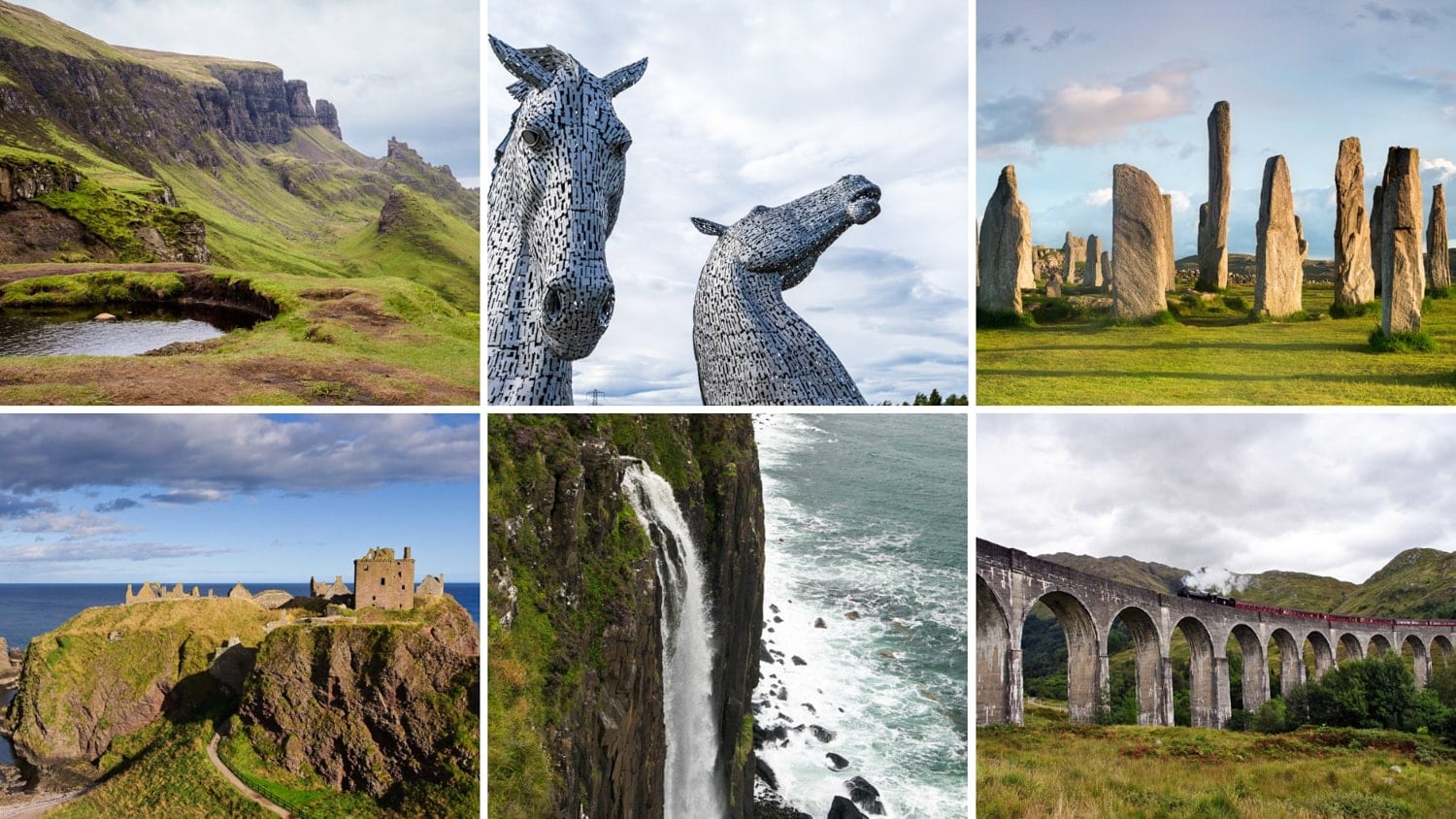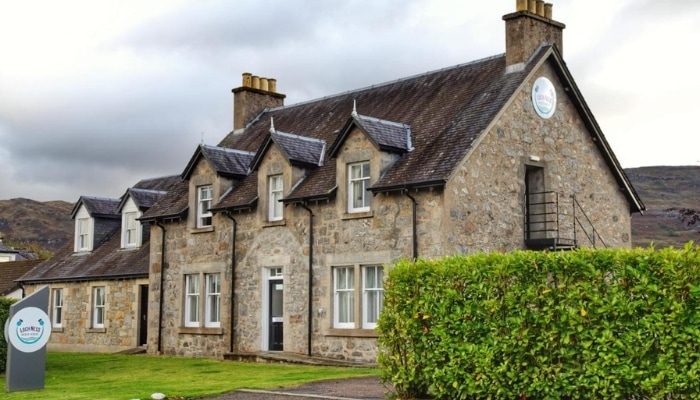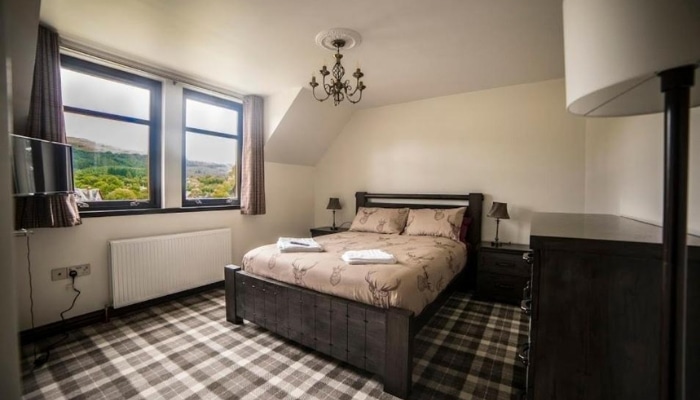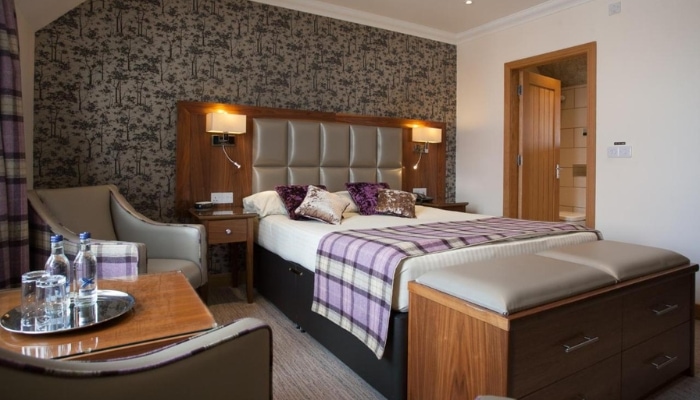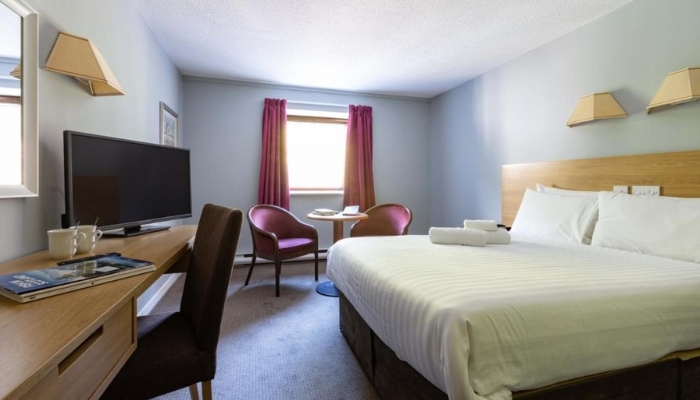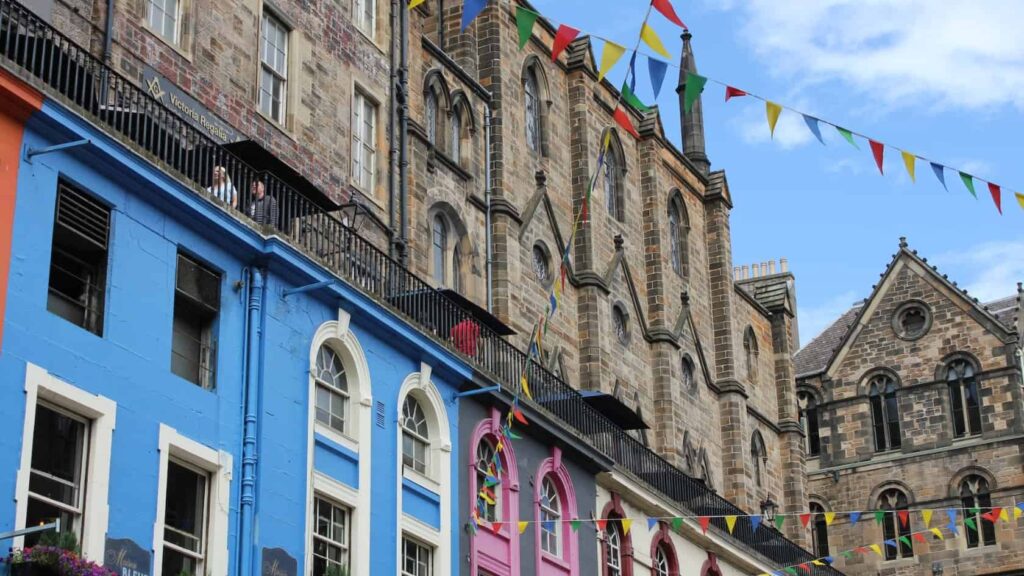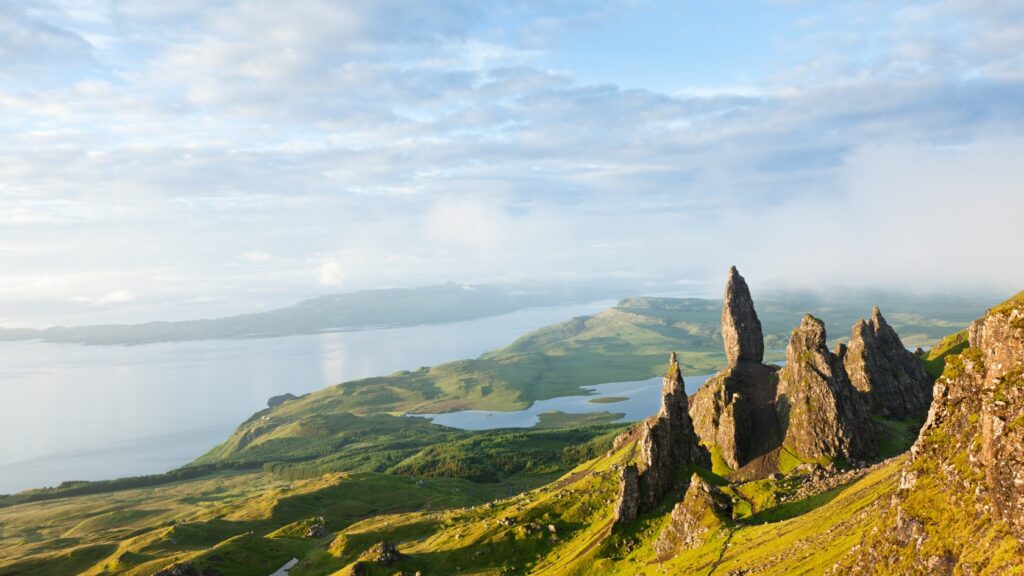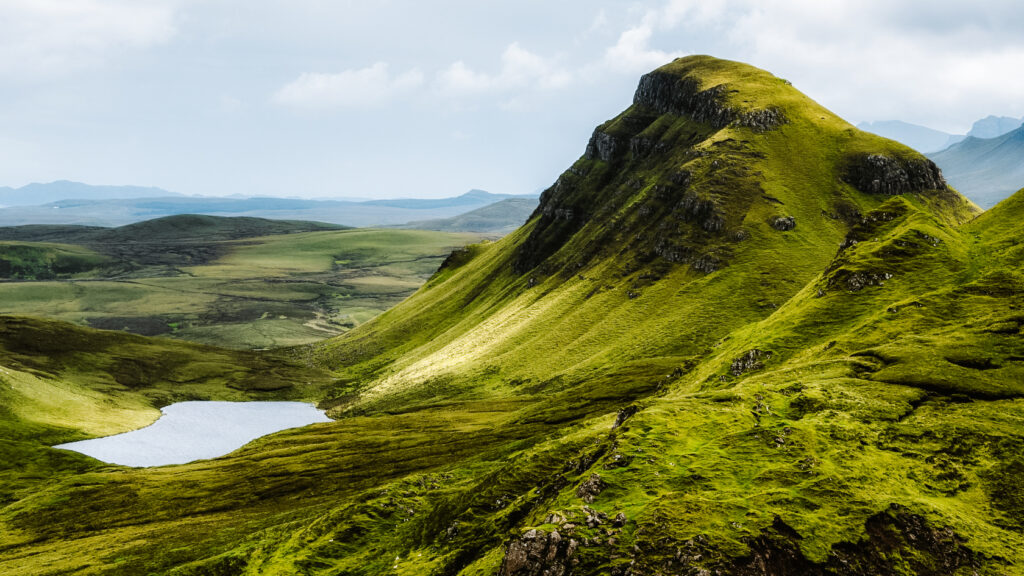Scotland is a region rich in history, a culture steeped in mysterious myths and a landscape that caresses the soul with its beauty. Join us on an adventure to see the things to do in Scotland.
I visited Scotland a few years ago during a roadtrip around the UK. And I was so excited that I can’t wait for the whole family to come.
In this article we look at best places to visit and things to do in Scotland. The article also includes tips on where to stay – divided by region, so you can get a better idea of what’s around and what trips you can take nearby.
To help you plan your Scotland itinerary, you can use the map at the end of this article to find things to do in Scotland.
How to get around Scotland
Organized trips
Choose Edinburgh, Glasgow or Inverness as your base and take trips from there. Guided tours include transport by air-conditioned coach or minibus and take you to some of the most beautiful places in the Scottish Highlands and the Isle of Skye.
This is a popular and eco-friendly way to experience Scotland. In high season, trips sell out early, so book well in advance (you can cancel 24 hours in advance if necessary).
Public transport
Scotland has a dense network of train and bus routes. Use this link to search for bus services, train services are operated by ScotRail.
Car rental
The car is another popular way to explore Scotland’s beautiful countryside. Rent a car and drive the entire North Coast 500 (more info later in the article) or head to the Isle of Skye. Just think about driving on the left in the UK.
Book your car well in advance to ensure the best price and choice. Car rental companies can be found at every airport, as well as throughout Scotland. When booking, make sure that full insurance is included to avoid any unpleasant surprises on site.
To rent a car you will need a passport, credit card and a minimum age of 21 years. Detailed information can be found at booking a car.
Things to do in Scotland: Best places to visit
Below you will find the best things to do in Scotland. You can also find all the places marked on the map at the end of the article. You can download and edit the map to your liking, or calculate the length of the route between places and plan your itinerary for your holiday in Scotland.
Let’s take a look with us at what places to visit in Scotland:
1. Edinburgh
Edinburgh, the capital of Scotland, perfectly captures the atmosphere of the whole country. You won’t find here the colour and playfulness of Barcelona, nor the sunshine of Lisbon or the elegance of Paris.
In Edinburgh, the fresh wind whips your face, you climb or descend downhill thanks to the undulating terrain here, and enjoy the places where the medieval and later Georgian periods are imprinted.
Edinburgh was the inspiration for JK Rowling when writing Harry Potter.

Visit Edinburgh Castle, walk the Royal Mile where bagpipers in plaid kilts play, sample real Scotch whisky and climb Arthur’s Seat for the best view of the city. There are so many great things to do in Edinburgh – set aside at least 2 days to visit the city.
Read: The best places to visit in Edinburgh + complete guide.
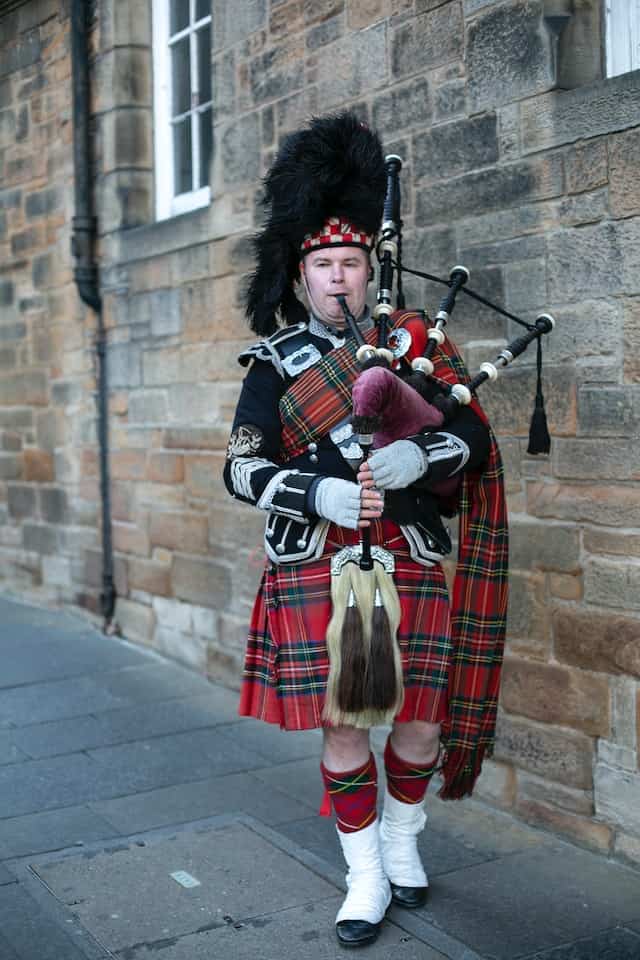
Tip: Edinburgh is a great base for trips to the Scottish Highlands. This trip to the Scottish Highlands includes Visits to Glen Coe and Loch Ness, including transport by air-conditioned coach. Would you like to visit the Isle of Skye too? Enjoy 3 days in the Scottish Highlands and on the Isle of Skye where you’ll see the best of Scotland.
2. Loch Ness and Urquhart Castle
Loch Ness is undoubtedly the most famous loch in Scotland. He’s also the most secretive. Who hasn’t heard of the Loch Ness Monster, or “Nessie”, which is said to lurk beneath its dark surface.
And this is what attracts many tourists from all over the world hoping to see the famous monster. I didn’t see it, but the lake itself, set in beautiful nature, is definitely worth seeing.
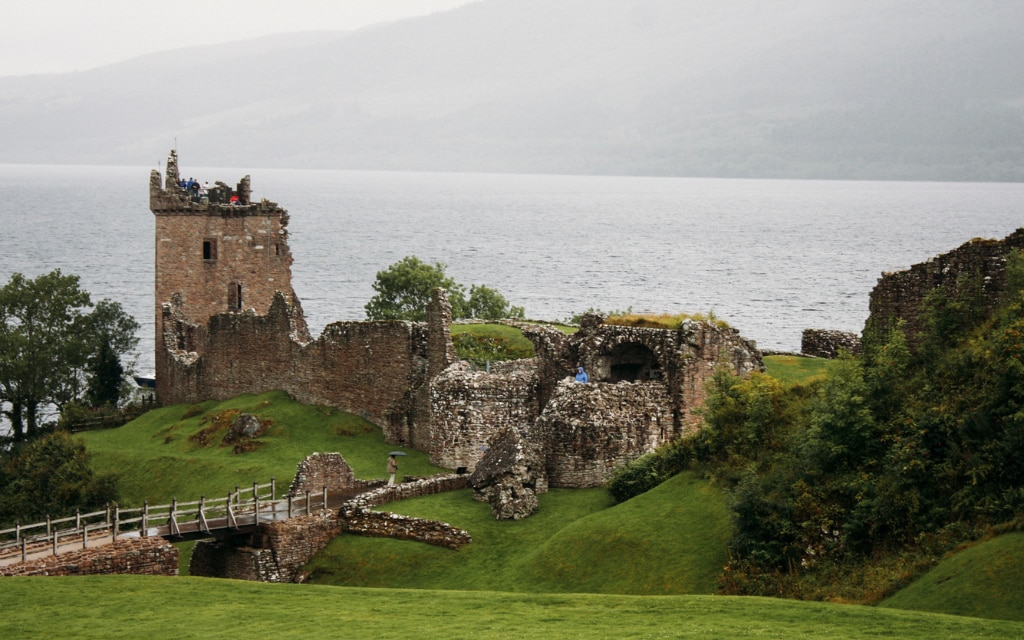
Loch Ness is the second largest loch in Scotland and, at 230 metres deep, one of the deepest. This gives the loch a gloomy atmosphere that adds to the legend of the Loch Ness Monster.
One of the biggest attractions around Loch Ness is the ruins of Urquhart Castle, where you can enjoy spectacular views of the loch and learn more about the history of the castle and the area. Click here for up-to-date information on opening times and admission to Urquhart Castle.
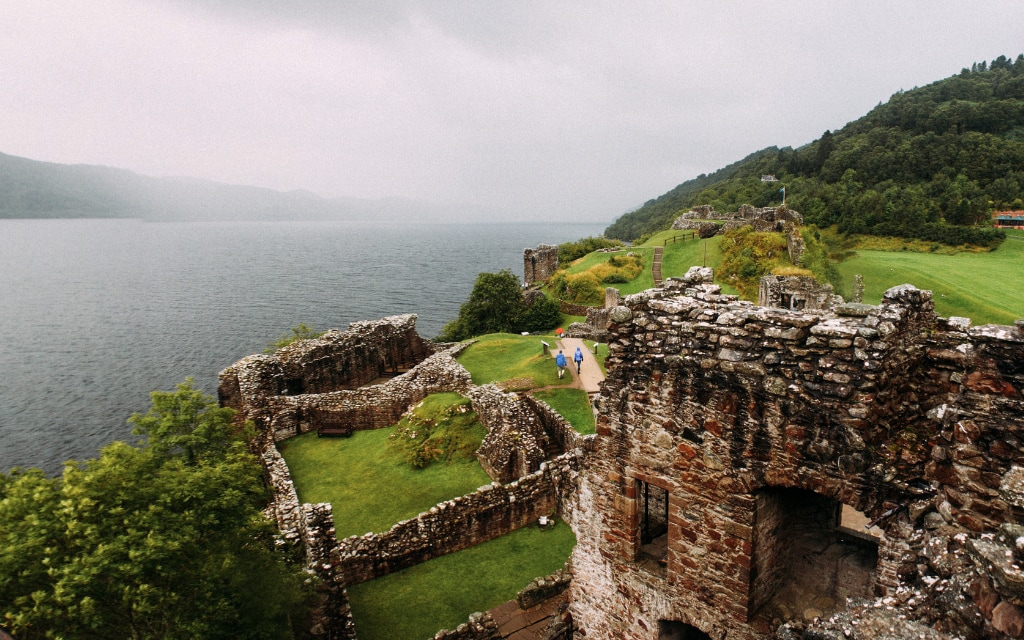
How to get to Loch Ness
There is a well-maintained road leading from both sides of the lake, but there is usually no access to the lake. Along the northwestern edge of the lake, there are several free parking spots along the road where you can stop and enjoy the lake.
Loch Ness is most easily accessible from the town of Fort Augustus in the south of the loch or from Clansman Harbour in the west of the loch. Great views can also be enjoyed from the ruins of Urquhart Castle, where there is free parking.
Loch Ness cruises
Sailing on the loch is one of the best things to do on Loch Ness. This one-hour boat cruise starts at Clansman Harbour and takes you past Urquhart Castle and back.
Or head to a two-hour cruise across the entire lake – The boat departs from Dochgarroch in the north of the lake at Inverness and sails past Urquhart Castle and south into the Caledonian Canal.
Best Loch Ness and Inverness Hotels 😴
3. Cairngorms National Park
The Cairngorms National Park covers an area of over 4,500 km² in the eastern part of Scotland, making it the largest national park in the UK. It’s even twice the size of Scotland’s other two national parks combined.
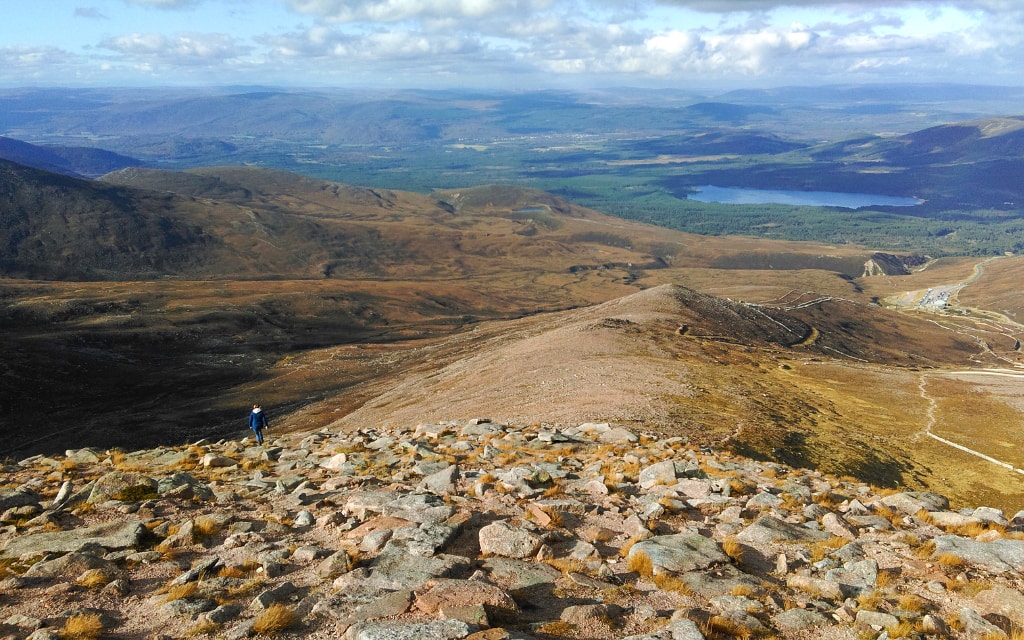
The landscape in the park is very diverse and includes mountain peaks, extensive forests, peat bogs, rivers and lakes. Five of the six highest mountains in the UK are in the Cairngorms. Still, it’s an area that escapes the tourist crowds (especially the foreign ones), so if you’re looking for a quieter destination in Scotland, the Cairngorms National Park is the perfect place.
If you’re coming here for the first time, a good base is Aviemore, a tourist resort that thrives on skiing in winter and is a great base for hiking and cycling in summer. From here, you can head to Loch Morlich, which is surrounded by Glenmore Nature Park with plenty of walking trails. It is unique in that it is home to an ancient forest that once covered much of Scotland.
Read: The complete guide to Scotland
4. Glasgow
Situated on the River Clyde in the western lowlands of Scotland, Glasgow is a city renowned for its vibrancy, warmth and rich history. It’s a place where stunning Victorian architecture coexists with cutting-edge design and where the locals will delight you with their friendliness and wit.
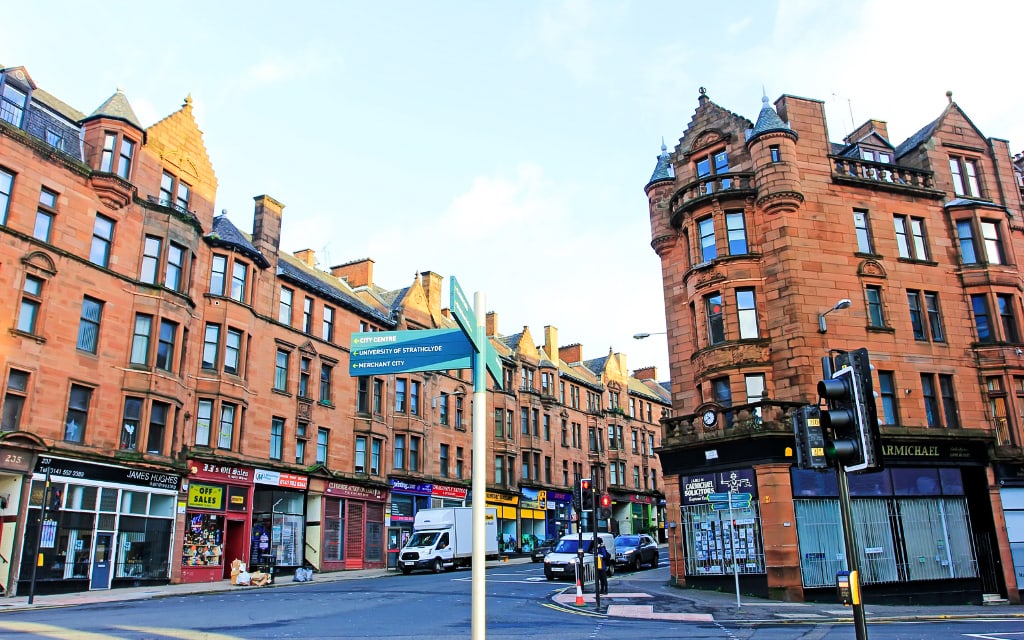
Originally a small rural settlement, it blossomed during the Industrial Revolution into one of the world’s leading centres of trade and shipbuilding. Its rich past is evident in the magnificent buildings such as Glasgow City Chambers, Glasgow University and the fascinating Kelvingrove Art Gallery and Museum.
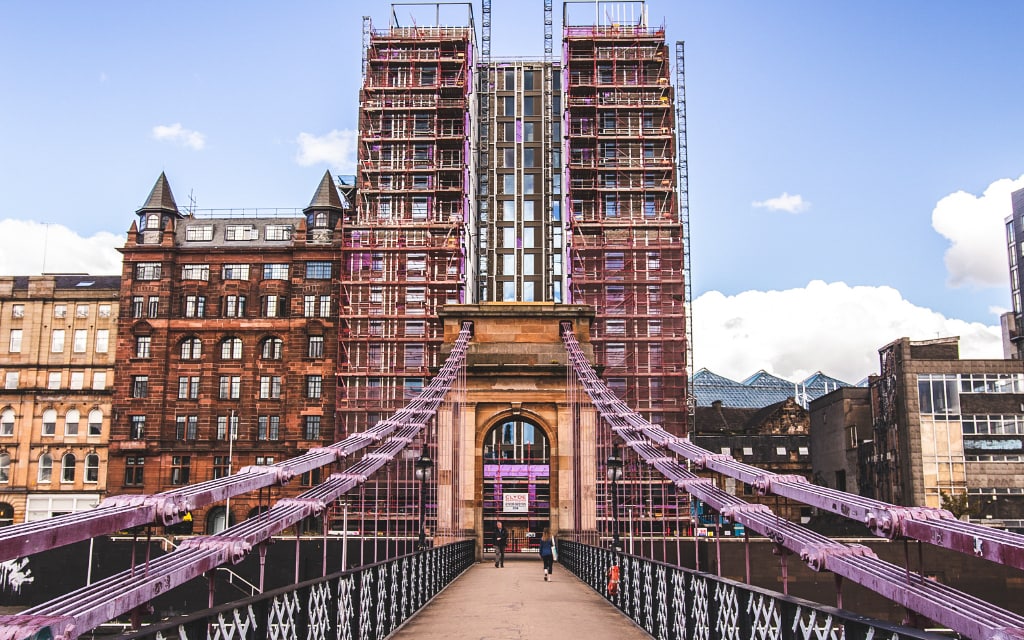
Glasgow is a UNESCO City of Music and hosts an average of 130 music events each week, from rock and pop concerts for the general public to classical concerts at the spectacular Glasgow Royal Concert Hall.
Tip: There are a number of excursions you can take from Glasgow. Visit Edinburgh or
head to the Scottish Highlands
on a guided tour to visit some of the most beautiful places in the Scottish Highlands.
5. Kelpies and Falkirk Wheel
The Kelpies – things to do in Scotland
The Kelpies, two monumental horse statues towering over the Falkirk countryside, are one of Scotland’s most admired and unique attractions. These stunning buildings, 30 metres high, pay tribute to Scotland’s industrial past and the role of horses in it.
The Kelpies, designed by acclaimed sculptor Andy Scott, were inaugurated in 2013 as part of the Helix project to transform the area between Falkirk and Grangemouth.
The name “Kelpies” comes from Scottish folklore, where there is a water spirit that usually takes the form of a horse, known for its strength and power.
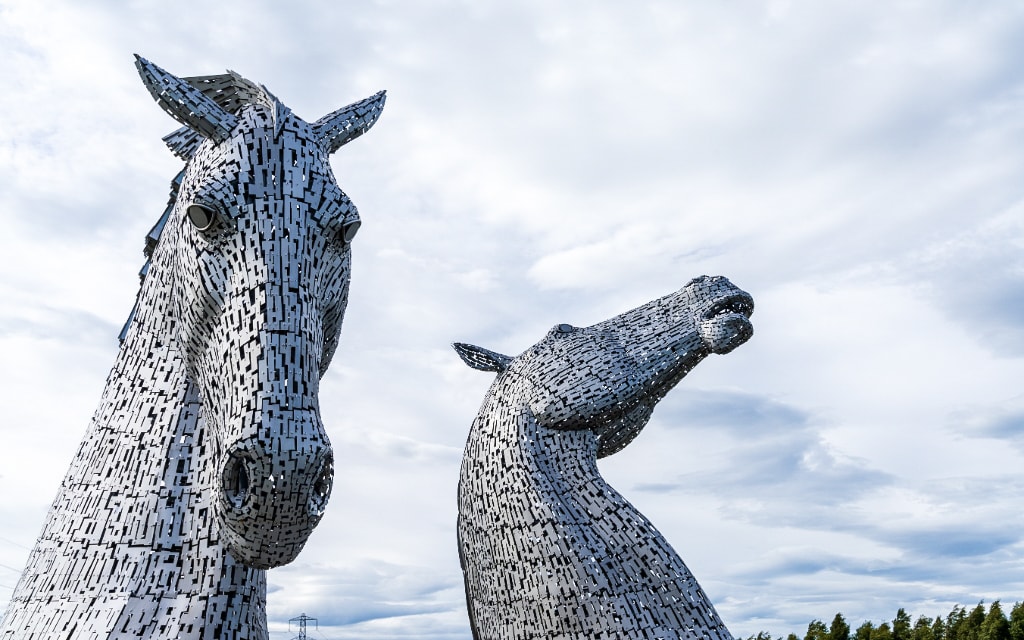
The Kelpies are located in a beautifully landscaped park next to the Forth and Clyde Canal. It serves as a dramatic gateway to the canal on the east coast of Scotland.
During the tour, you will explore the interior of the artworks, learn about the artist’s vision and the rich tradition that inspired the buildings. For up-to-date information on tours and opening times, please visit the official website.
Falkirk Wheel – things to do in Scotland
Not far from here is a unique technical attraction – the Falkirk Wheel. It is the only rotating boat lift in the world, uniquely designed to connect the Forth and Clyde Canal with the Union Canal.
The design has replaced a number of locks as it lifts ships up to 24 metres thanks to a unique mechanism that uses the Archimedes principle of buoyancy.
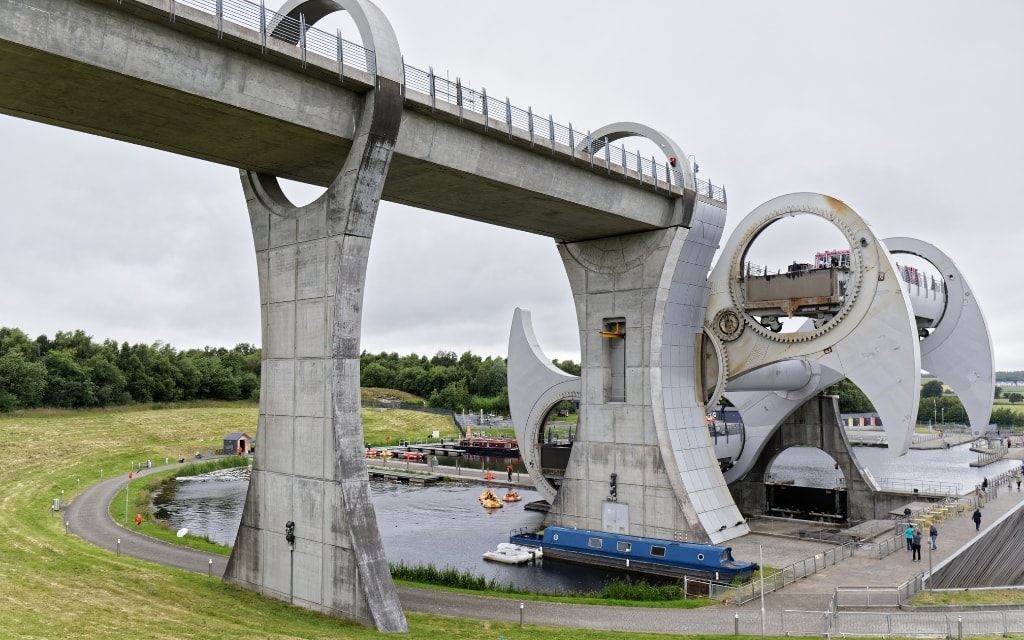
The Falkirk Wheel opened in 2002 and is shaped like a double-headed Celtic axe. Click here for more information to visit the Falkirk Wheel.
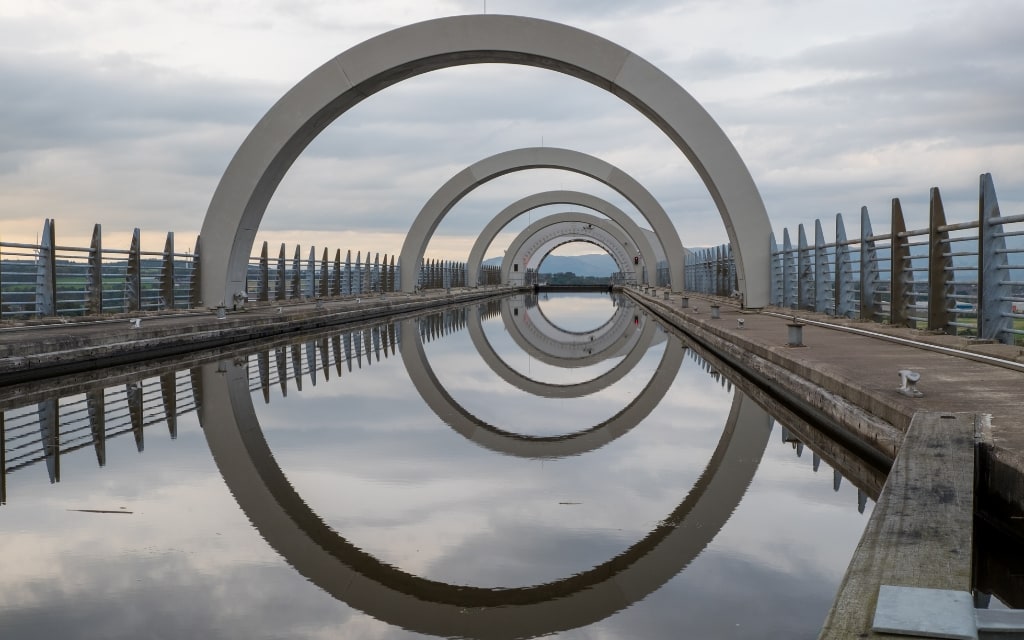
6. Stirling Castle
Perched atop Castle Hill, Stirling Castle is one of the most famous and historically significant landmarks in Scotland. The castle is the birthplace of Mary Queen of Scots and its strategic location made it a key player in the Scottish Wars of Independence.
Its combination of military and royal architecture, including the magnificent Great Hall and Chapel Royal, is magnificent. See the tapestries and interactive exhibitions about Scotland’s rich history. From the walls you can enjoy a magnificent view of the surroundings.
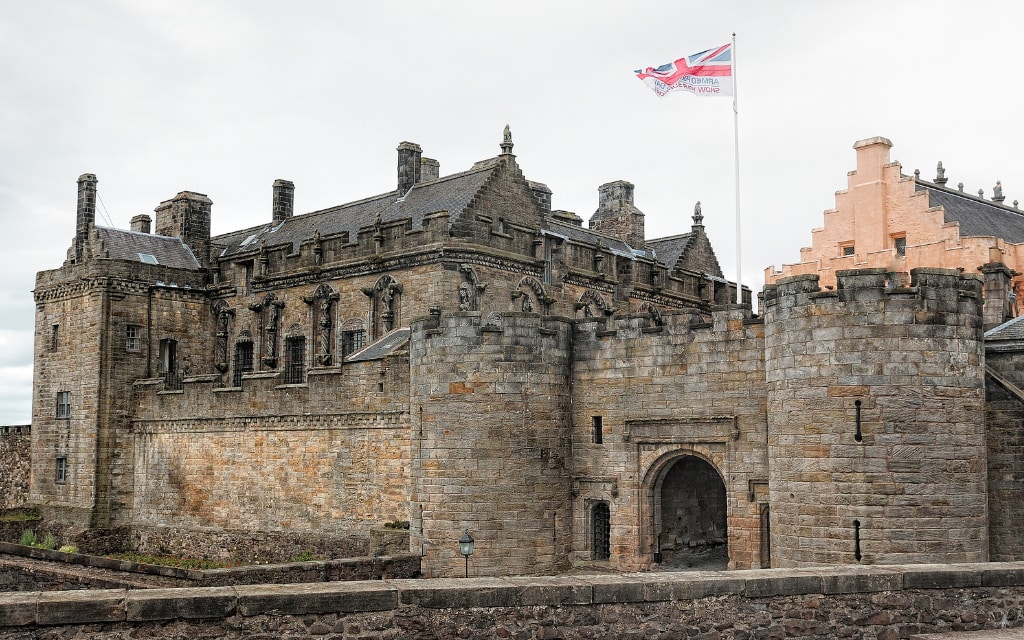
Here you can find more information about the price and opening times of Stirling Castle. Paid parking is located directly at the entrance to the castle, or at the entrance to the castle. You can arrive by direct train from Edinburgh (1 hour).
Hotels in Scotland 😴
7. Loch Lomond and The Trossachs National Park
Loch Lomond and The Trossachs National Park covers an area of 720 square miles in west central Scotland.
The heart of the park is Loch Lomond itself, the largest freshwater loch in mainland Britain. Loch Lomond is dotted with around 30 islands, some of which are home to a variety of wildlife.
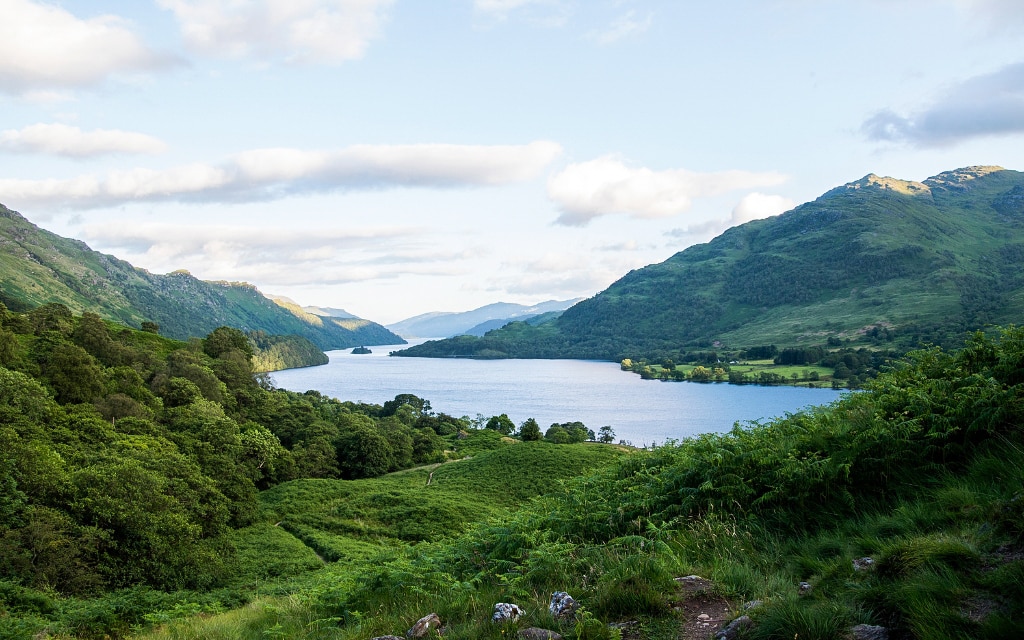
Park in Rowardennan and walk around the lake on the West Highland Way, which runs across the National Memorial Park with its 3 metre high circular memorial dedicated to the fallen of the war.
Or head to boat cruise – Boats depart from Balloch and there are a choice of one or two hour cruises.
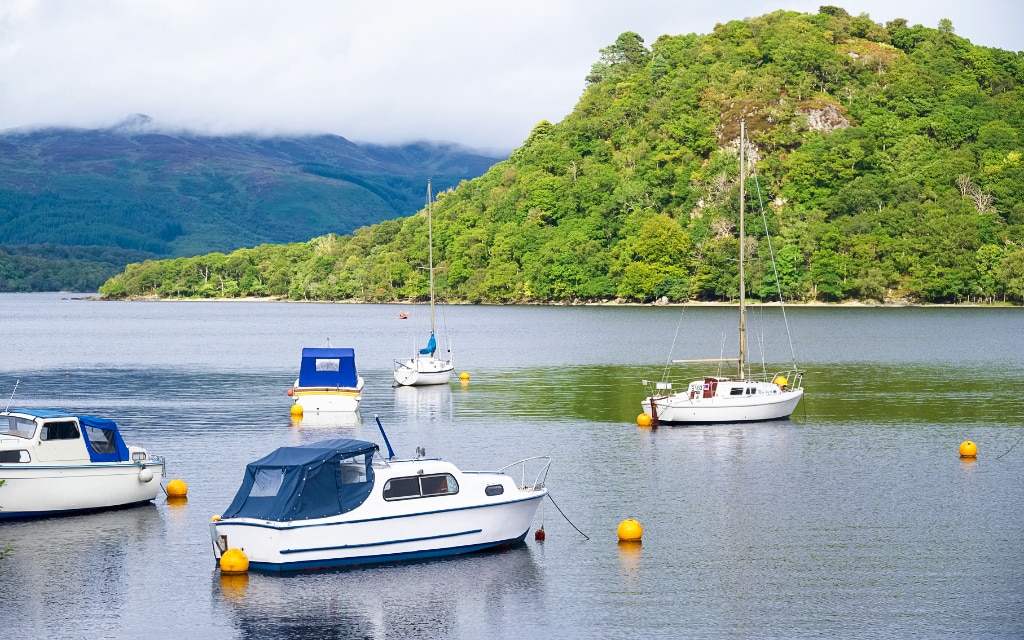
Even if you’re not planning a cruise, Balloch is a good base for exploring Loch Lomond. There’s an underwater aquarium, trails with seating around the lake, and Balloch Castle with a country park and views of the lake (the castle itself is inaccessible).
Or stop in the picturesque town of Luss, with its stone houses and small harbour to walk around.
Loch Ness is more popular, but I have to say I liked Loch Lomond better. It is less touristy and the local mountains create beautiful panoramas. This brings us to the next point…
8. Ben Lomond – things to do in Scotland
On the eastern shore of Loch Lomond, Ben Lomond, Scotland’s most southerly munro, rises majestically. Munro are Scottish peaks higher than 3000 feet (914 metres). And Ben Lomond is one of the most popular, which is also suitable for holiday tourists.
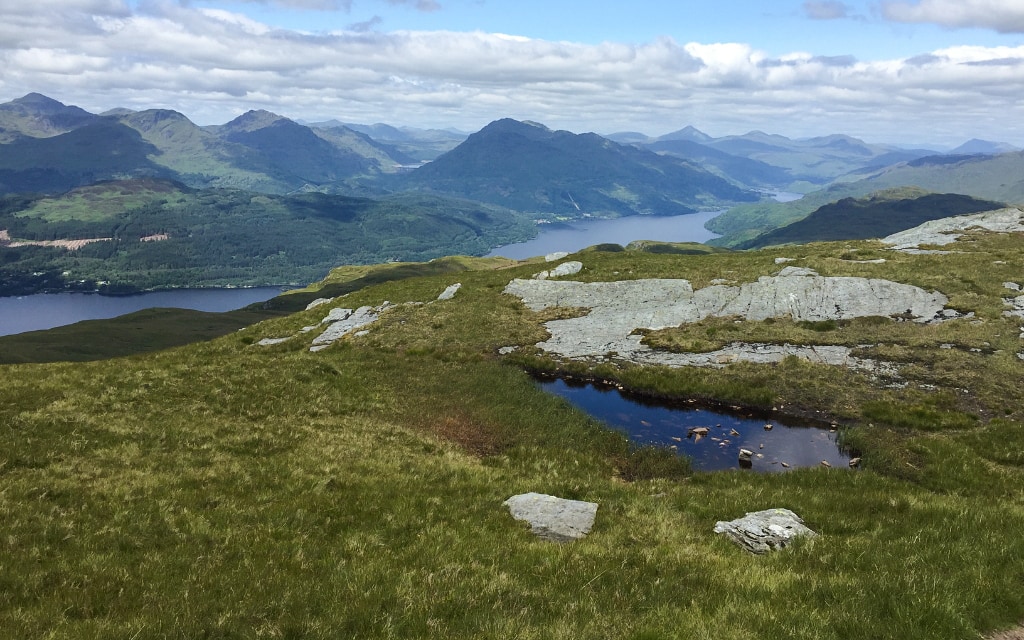
Ben Lomond is famous for its distinctive conical shape, which creates a stunning panorama of Loch Lomond. From its summit you can enjoy a fantastic view of the lake, the Trossachs and the entire national park.
How to get to Ben Lomond: The starting point is Rowardennan car park (small charge, fills up early), from where you follow a well-maintained and mostly wide path to the summit. Allow about 2-2.5 hours for the ascent.
9. Glen Etive
The Scottish Highlands are beautiful. However, it can be crowded with tourists in some places. Glen Etive is the place to enjoy its quiet beauty without the crowds. A hidden gem that caught the attention of the producers of the James Bond film Skyfall.
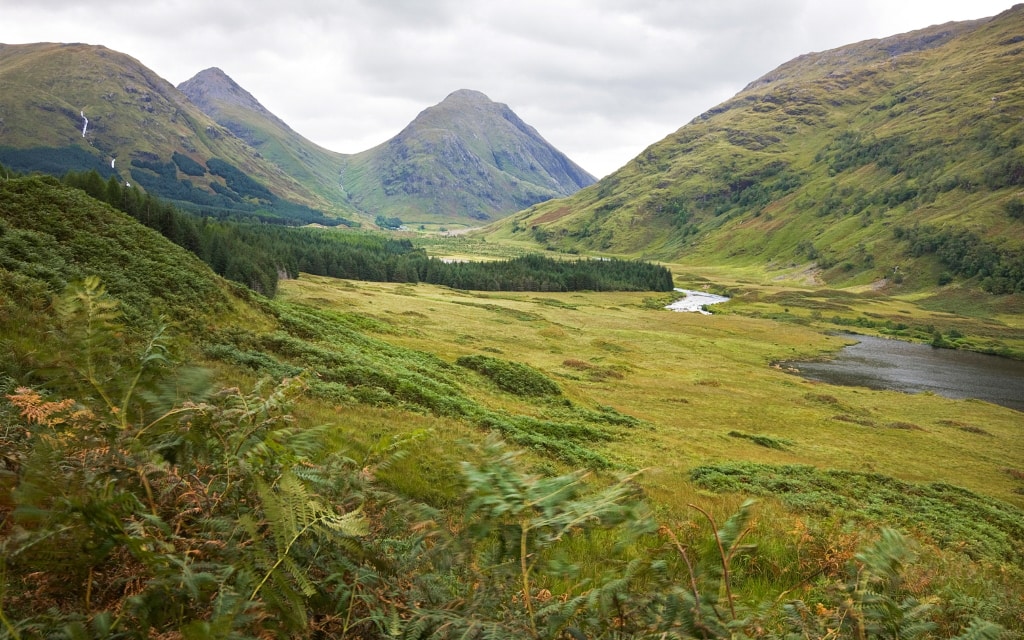
The Etive River meanders through the valley, forming dramatic cascades in places. Wild deer roam freely at the foot of the high Munros and you just walk quietly and soak up the atmosphere of the wild Scottish Highlands.
There is a turn off the A82 into the Glen Etive valley. The road is narrow and in high season there can be a lot of cars, especially James Bond fans.
If you drive all the way to the end of Loch Etive to Gualachulain, there’s a small unpaid car park and much more quiet.
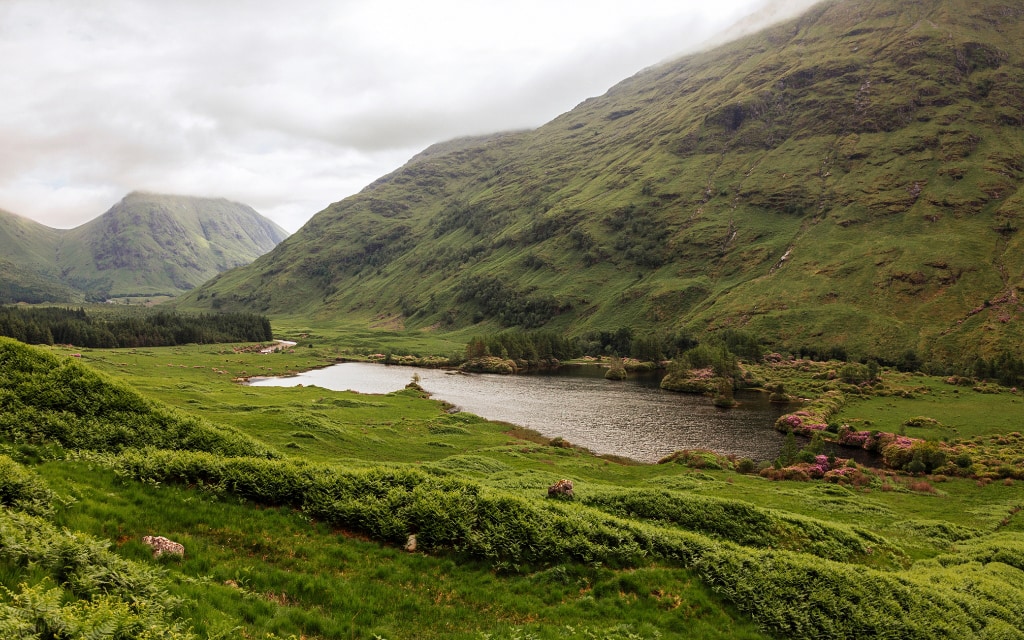
10. Oban and McCaig’s Tower
Oban, a charming seaside town on the west coast of Scotland, is known as the gateway to the islands. The town is famous for its busy harbour, from which ferries to the Hebridean islands depart.
In the town centre there are a number of seafood restaurants, traditional taverns and small independent shops. Learn about the whisky-making process and sample single malt whisky at the local distillery, one of the oldest in Scotland.
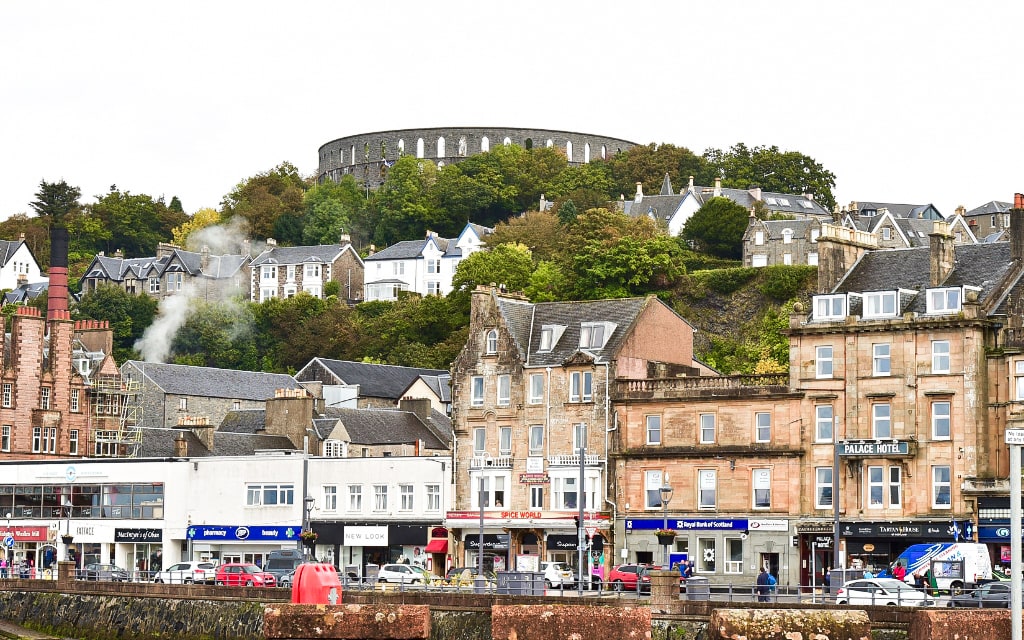
McCaig’s Tower, which rises above the city from Battery Hill, is an imposing granite structure built in the style of the Roman Colosseum. At the end of 19th In the 1700s, local philanthropist John Stuart McCaig had it built with the dual purpose of providing work for local stonemasons and creating a lasting memorial to his family.
The exterior of the tower consists of a circular facade with two levels of arches, from which there is a great view of Oban Bay and the surrounding islands. Inside there is a quiet garden ideal for walks.
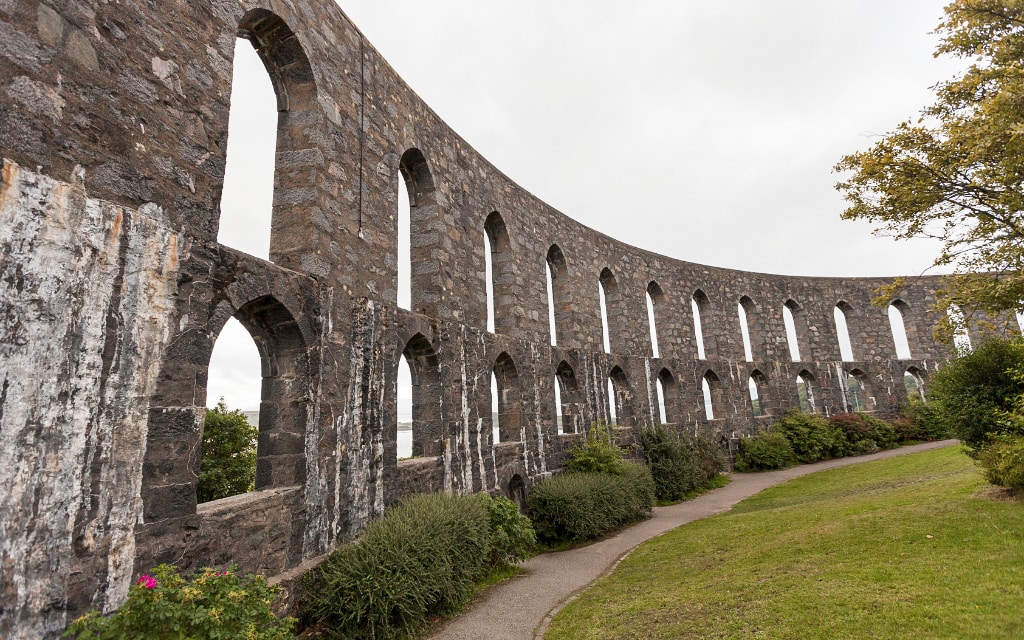
11. Glen Coe – things to do in Scotland
Glen Coe is one of the most beautiful places to visit in Scotland. A rugged glen known for its sweeping valleys, high mountains and sparkling fells, it is the epitome of Scotland’s raw wilderness. The majestic landscape has served as a backdrop for films such as James Bond’s Skyfall and several Harry Potter movies.
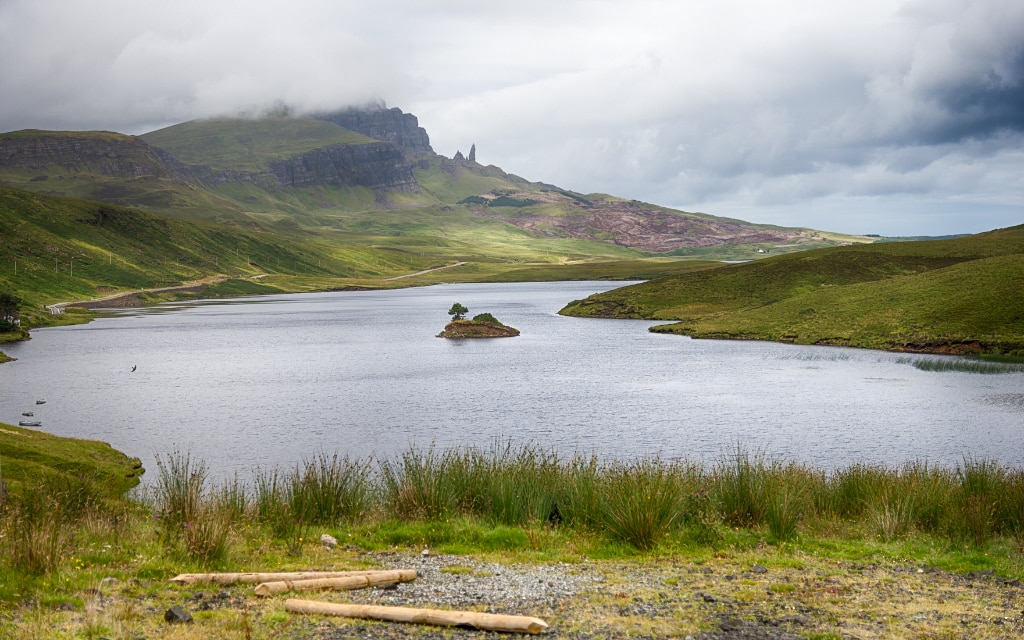
The Glen Coe terrain is a paradise for outdoor enthusiasts and there is a choice of trails of varying difficulty, including the family-friendly Glen Coe Lochan.
Looking for more adventure? Climb the munros of Bidean nam Bian or Buachaille Etive Mor. Or take a hike to the Hidden Valley, overlooking the peaks of the Three Sisters, one of the best things to do in Scotland. There is a parking lot with a view at the beginning of the hike.
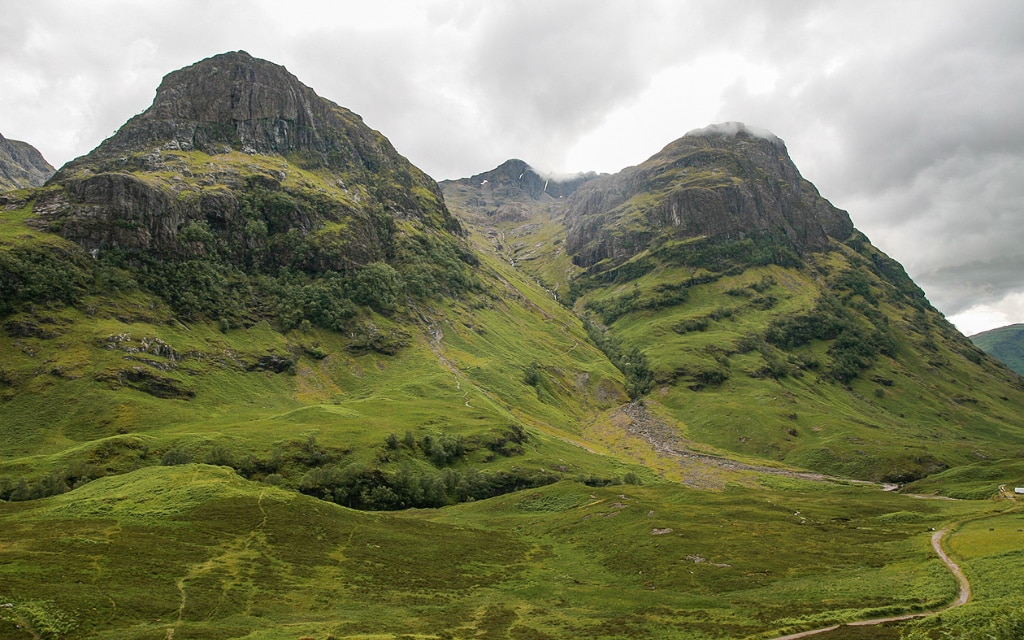
How to get to Glen Coe
The journey to Glen Coe is an adventure in itself. If you’re coming from Glasgow, it’s about a two-hour drive along the A82 through some of Scotland’s most stunning countryside. Before entering the gorge, you’ll cross the shores of Loch Lomond and travel across the desolate moors of Rannoch Moor. There are several car parks around the A82.
If you prefer public transport, there are also buses from Glasgow to Glen Coe. The journey takes over 3 hours, but it passes like water while observing the Scottish landscape.
For more information about the trails and Glen Coe, visit the visitor center here. In addition, the visitor centre will give you an insight into the infamous Glen Coe Massacre of 1692.
Tip: Edinburgh is a great base for trips to the Scottish Highlands. This trip to the Scottish Highlands includes Visits to Glen Coe and Loch Ness, including transport by air-conditioned coach. Would you like to visit the Isle of Skye too? Enjoy 3 days in the Scottish Highlands and on the Isle of Skye where you’ll see the best of Scotland.
12. Ben Nevis
Ben Nevis, located in the Grampian Mountains in Scotland, boasts the title of the highest mountain in the UK due to its height of 1,344 metres. The drive up is already full of spectacular views of Loch Lomond and the Glen Coe valley. Despite the moderate difficulty of the route, many tourists head up to climb the UK’s highest mountain.

How to get to Ben Nevis
The starting point is the Glen Nevis Visitor Centre near Fort William. You can get here by car, local bus and a popular option is a taxi.
The climb up is not demanding, but it is long with a big elevation gain – count on 4 hours for the climb. Bring plenty of food, drink and an extra layer as the weather changes quickly up there.
Hotels around Glencoe and Ben Nevis 😴
13. Glenfinnan Railway Viaduct
Whether you’re a Harry Potter fan or not, you can’t miss the Glenfinnan Railway Viaduct.

The Glenfinnan Viaduct is a remarkable piece of engineering in the heart of the Scottish Highlands. It was built between 1897 and 1901 to a design by Sir Robert McAlpine as part of the West Highland Railway. The viaduct is 380 metres long and consists of 21 arches, each of which has a span of 15 metres and reaches a height of up to 30 metres.
The viaduct was made famous in the Harry Potter film series, where the Hogwarts Express raced through great curves against the backdrop of the Scottish Highlands.
If you want to see a train crossing the viaduct, be sure to check the train times.
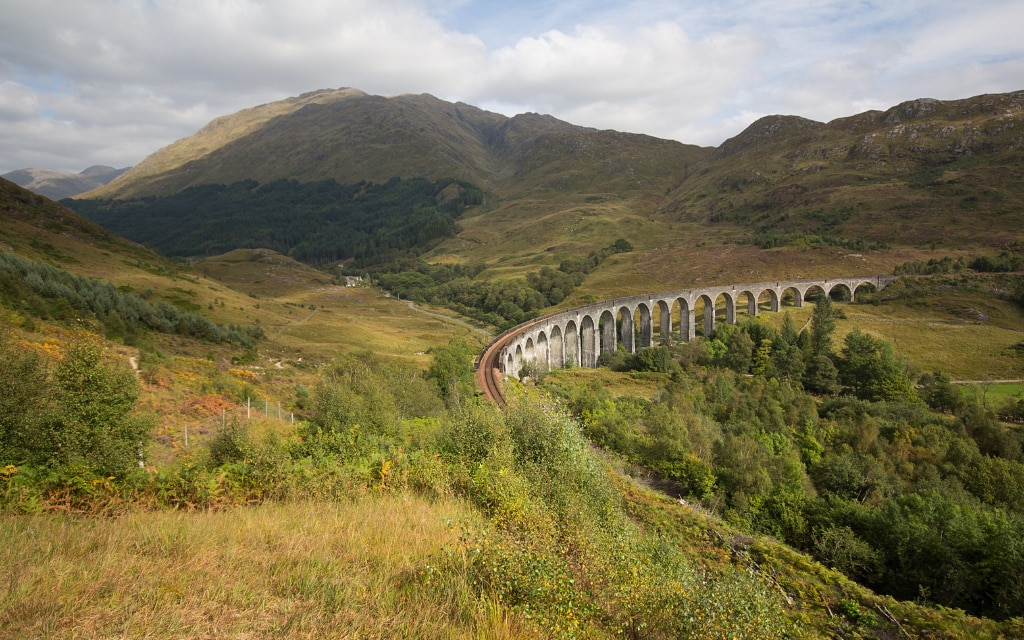
How to visit Glenfinnan Viaduct
By car
If you are driving, Glenfinnan is on the A830, often referred to as the ‘Road to the Islands’, which connects Fort William and Mallaig. From Fort William to Glenfinnan is approximately 30 minutes by car. There is a visitor centre with a car park near the viaduct, but it can be busy in the peak tourist season.
By train
One of the best ways to see the Glenfinnan Viaduct is by train. Directly over the viaduct runs the West Highland Line, one of the most scenic railway lines in the world. Trains run from Glasgow to Mallaig, stopping at Glenfinnan station. From the station it is only a short walk to the viaduct viewpoint.
By bus
There are also bus services from Fort William to Glenfinnan. On arrival, it’s about a 10-minute walk to the Glenfinnan Monument and from there you can follow the footpath to the viaduct viewpoint.
The viaduct also offers a journey along one of the most scenic railway lines in the world, the West Highland Line, which provides panoramic views of the surrounding countryside including Loch Shiel and the Glenfinnan Monument. Follow this link to find out more about train timetables and prices if you would like to enjoy a ride on the West Highland Line.
14. Eilean Donan Castle
Eilean Donan Castle, one of the most beautiful places in Scotland, is situated on a small tidal island where three lochs – Loch Duich, Loch Long and Loch Alsh – meet.
Eilean Donan, which translates as “Donnan’s Island”, is named after Donnan of Eigg, a Celtic saint martyred in 617. The castle was originally built in 13th century to defend the land of Kintail from the Vikings. It has witnessed many conflicts throughout history, was destroyed in the 18th century during the Jacobite uprising and lay in ruins for almost 200 years.
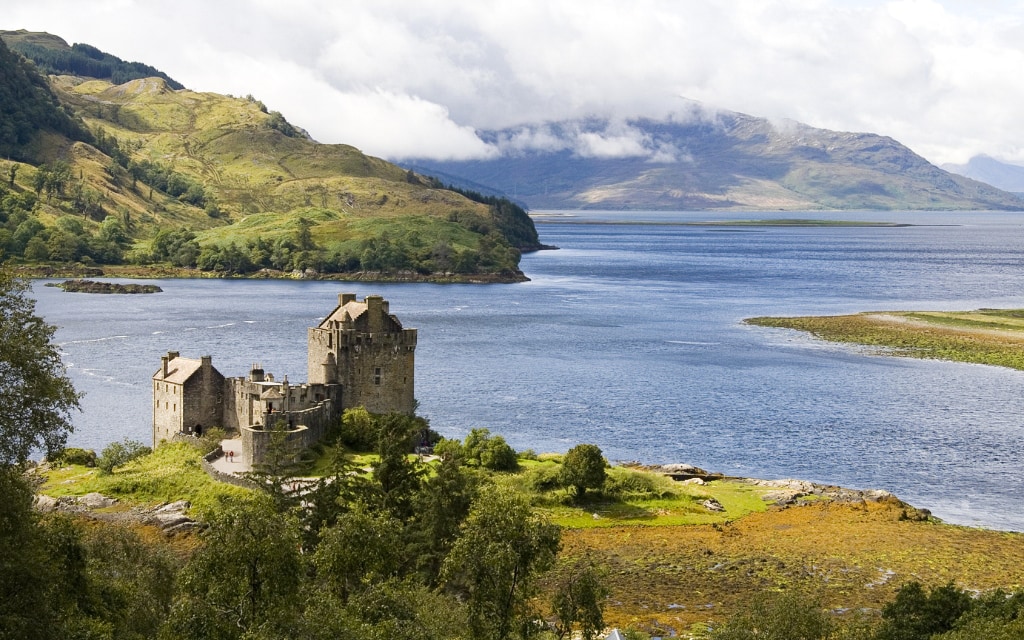
At the beginning of the 20th century, the island was bought by Colonel John MacRae-Gilstrap, who painstakingly restored the castle over a period of 20 years, giving it its present magnificent appearance.
For more information about opening hours and admission fees, check the official website. The castle can be reached by a stone bridge with a large car park, a souvenir shop and a café.
A sample itinerary for a roadtrip in Scotland will help you plan your trip.
15. Inverness – things to do in Scotland
On the banks of the River Ness, Inverness is a city steeped in magical stories and old traditions. It is the capital of the Scottish Highlands, known as the “Gateway to the Highlands”.
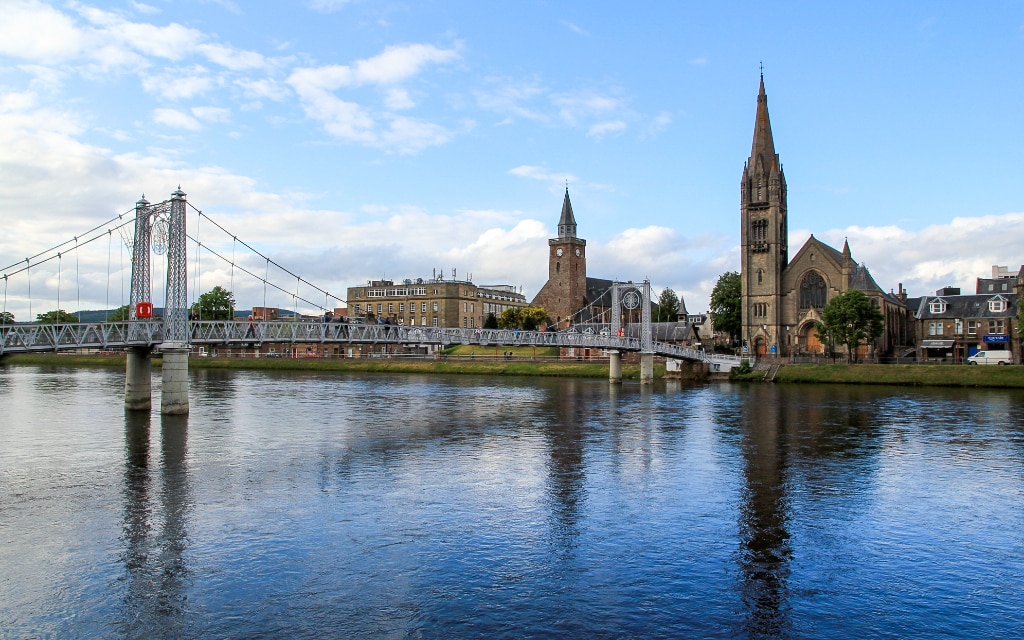
Historic sites such as Inverness Castle, St Andrew’s Cathedral and the Old High Church combine with modern attractions and a vibrant nightlife. Many venues feature live traditional music, and the city is also a centre of Scottish Gaelic language and culture.
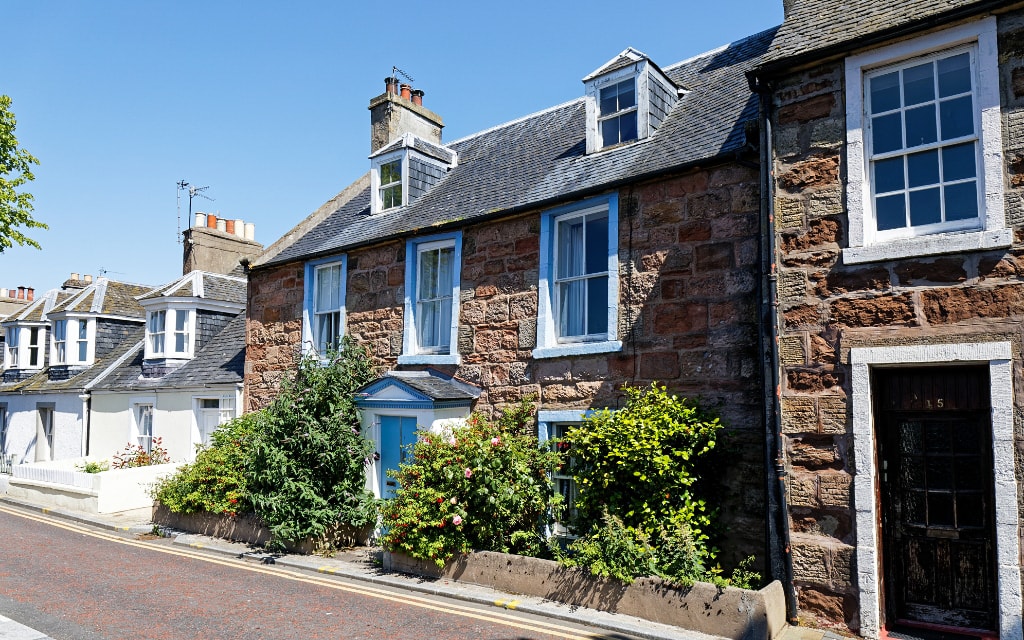
After you’ve explored the town, head to Loch Ness, just a short distance away, enjoy the views from Chanonry Point Lighthouse or visit Fort George, an 18th-century military fort.
Tip: You don’t need to hire a car and you can still explore the most beautiful places in the Scottish Highlands from Inverness. This popular tour includes a day trip to the Isle of Skye and the iconic Eilean Donan Castle. Or head to a trip to the Scottish Highlandswhere you’ll see the Jacobite steam train from Harry Potter.
16. Forth Bridges
Many locals will recommend Forth Bridges for you to visit. These are iconic bridges in South Queensferry, half an hour from Edinburgh.
The most famous is the red railway bridge, which is more than 125 years old. Today, thanks to its historical significance, it is a UNESCO World Heritage Site. The bridge connects South Queensferry and North Queensferry.
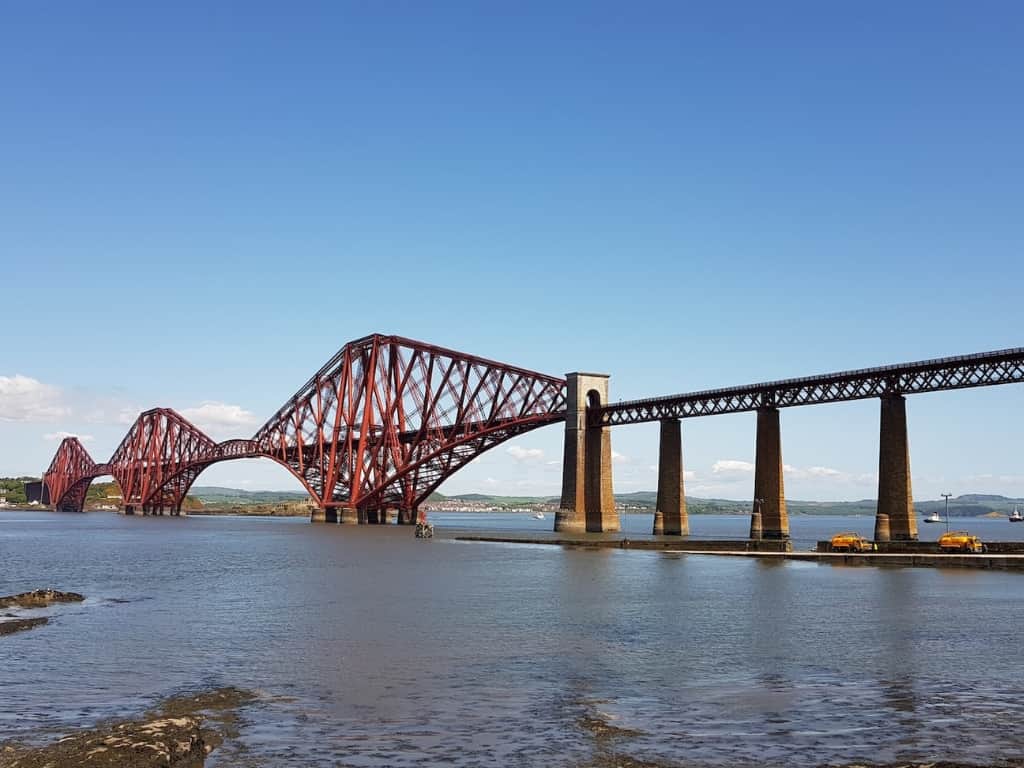
North Queensferry is a smaller village, famous for its Deep Sea World aquarium (one of the largest underwater tunnels in the world is worth seeing).
North Queensferry can be reached by train from Dalmeny Station. The journey takes just 3 minutes and costs £2.90. Driving over the Forth Bridge is an experience in itself.
Or take one of the walking trails, of which there are several. One starts at Dalmeny station in South Queensferry and is 8km long (can be cycled down). Along the way you will be guided by several information panels with interesting facts about the area.
The most popular option is sightseeing boat cruise. The ship sails right under the bridges and around Edinburgh. And you might be lucky enough to see puffins and sea lions in their natural habitat.
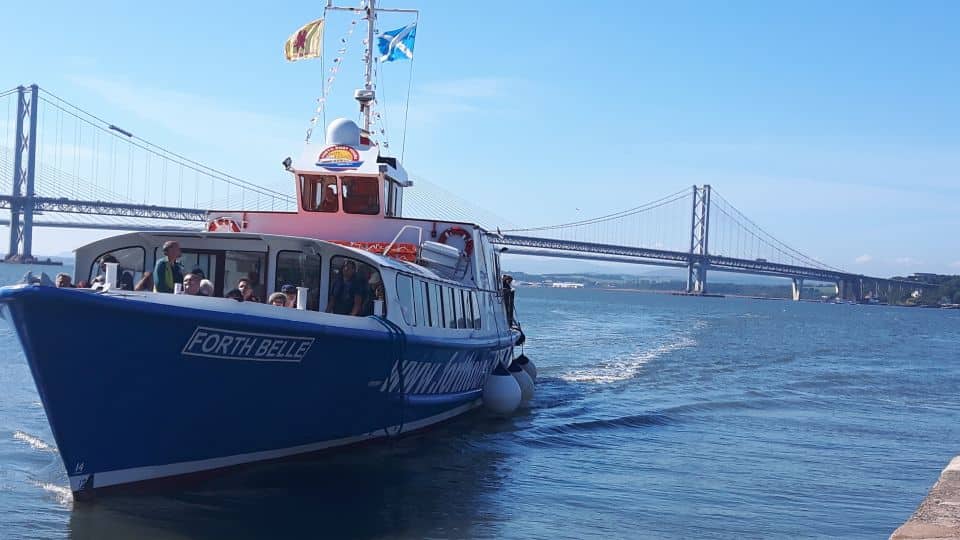
17. Dunnottar
Dunnottar Castle in Scotland is a dramatically sited, partially ruined fortress that sits atop a jagged cliff overlooking the North Sea. Located near the coastal town of Stonehaven in Aberdeenshire, it offers stunning views and a rich history.
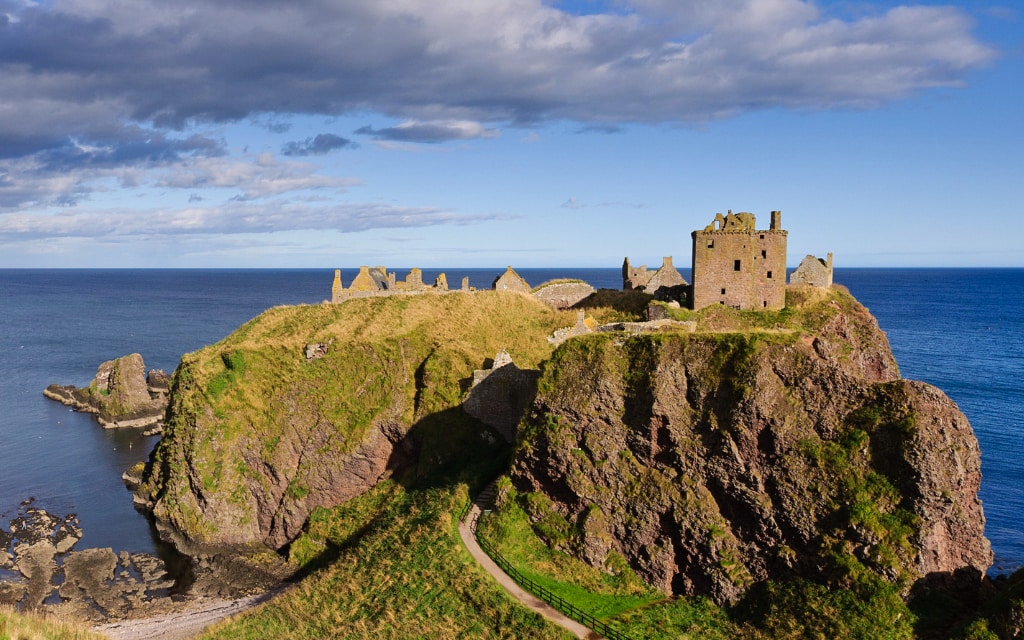
Dunnottar’s surviving buildings date from the 15th and 16th centuries, but the strategic importance of the site is thought to date back to the early Middle Ages or even prehistoric times.
The castle is famous for its role in Scottish history, particularly for hiding the Scottish Crown Jewels from Oliver Cromwell’s invading army in the 17th century. It was also the seat of the Earls of Marischal, one of the most powerful families in Scotland, and served as the backdrop for the 1990 film version of Hamlet starring Mel Gibson.
Follow this link for up-to-date information on admission fees and opening times.
Read: The most beautiful places in Ireland
18. St. Andrews
Situated on the east coast of Scotland, St Andrews is a beautiful place full of history. It is home to the University of St Andrews, the oldest university in Scotland and the third oldest in the English-speaking world.
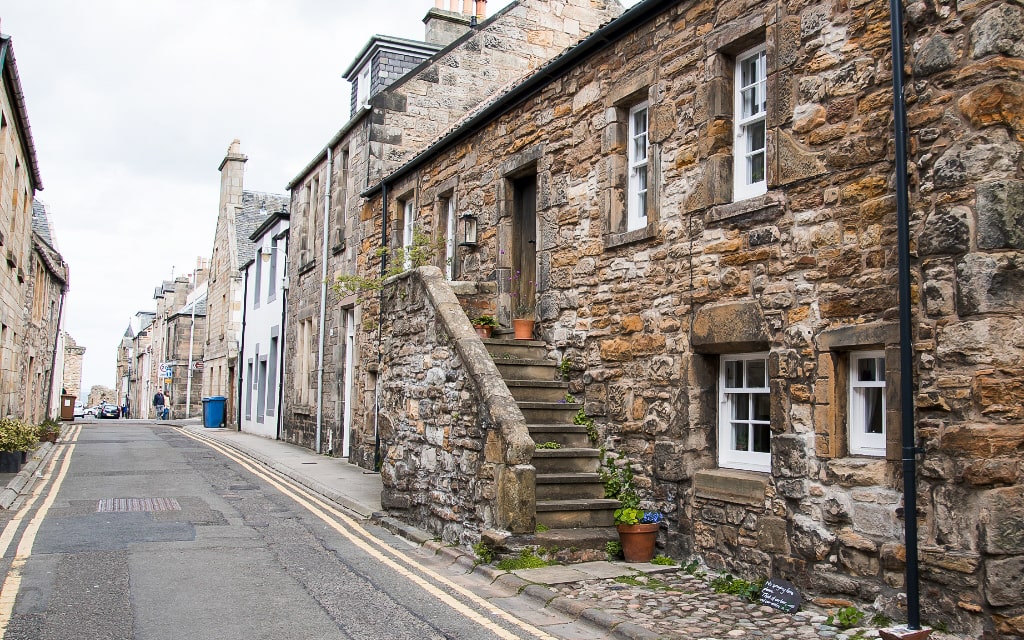
St Andrews has a medieval street layout, castle ruins and St Andrews Cathedral that literally transport you to Scotland’s living history. Wander the neat streets lined with stone houses or head to the beach, which is as full of atmosphere as St Andrews.
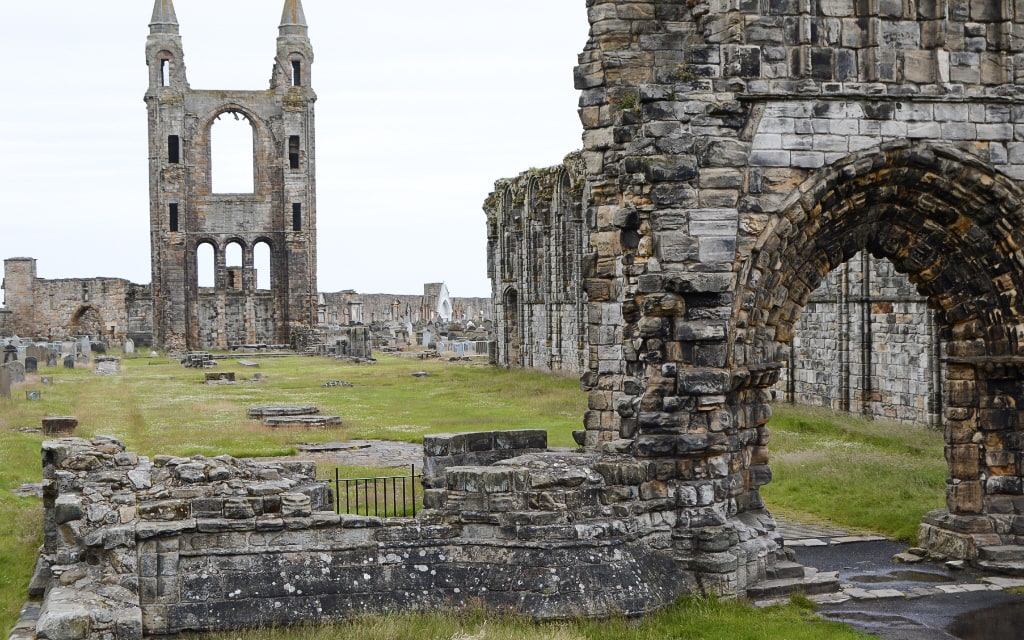
However, this city is not only famous for its history, but it is also known as the “home of golf”. The Old Course at St. Andrews, a mecca for golf enthusiasts worldwide, is one of the oldest golf courses in the world and regularly hosts The Open Championship.
19. Culloden Battlefield
Culloden is a village and ancient parish near Inverness, famous for the Battle of Culloden, the final clash of the Jacobite Rebellion in 1745.
Today Culloden Battlefield is protected as a war grave by the National Trust for Scotland. There is a visitor centre where you can learn about the battle and its significance in Scottish history.
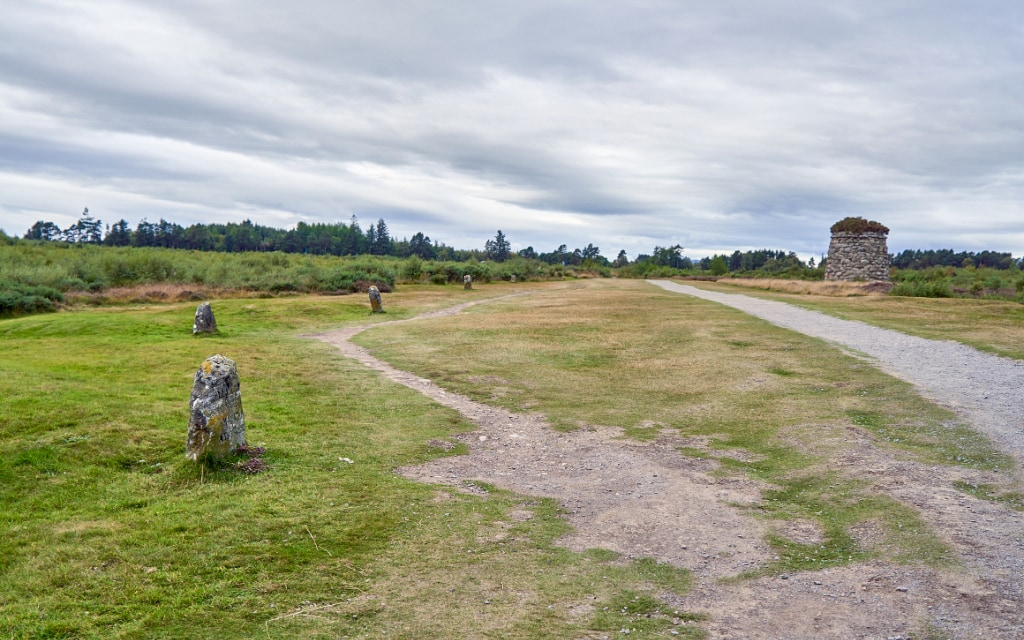
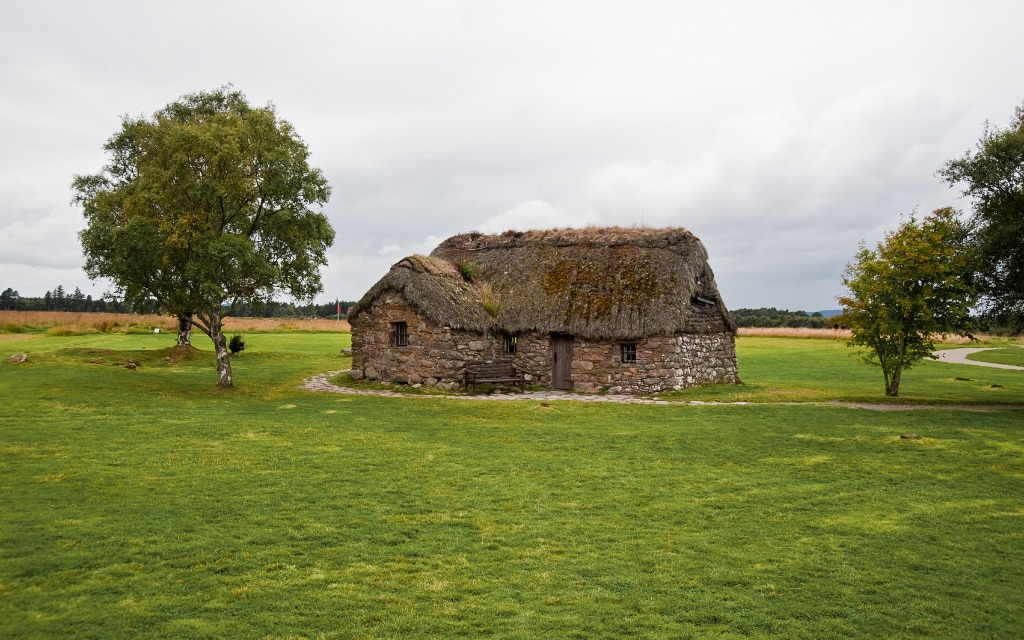
20. North Coast 500 Route
The North Coast 500, often referred to as “Scotland’s Route 66”, is a 500-mile route around the northernmost parts of the Scottish Highlands. This spectacular journey starts and finishes in Inverness and offers fantastic views of the Scottish landscape, including rugged mountains, tranquil lochs and white sandy beaches. You’ll discover wildlife and hidden places in remote corners of Scotland.

In addition, the route passes through picturesque towns and villages where you can experience traditional Highland hospitality and sample the best local produce, seafood and of course Scotch whisky. Another advantage is that it is not as crowded as other parts of Scotland. You can find the North Coast 500 route marked on the map at the end of this article.
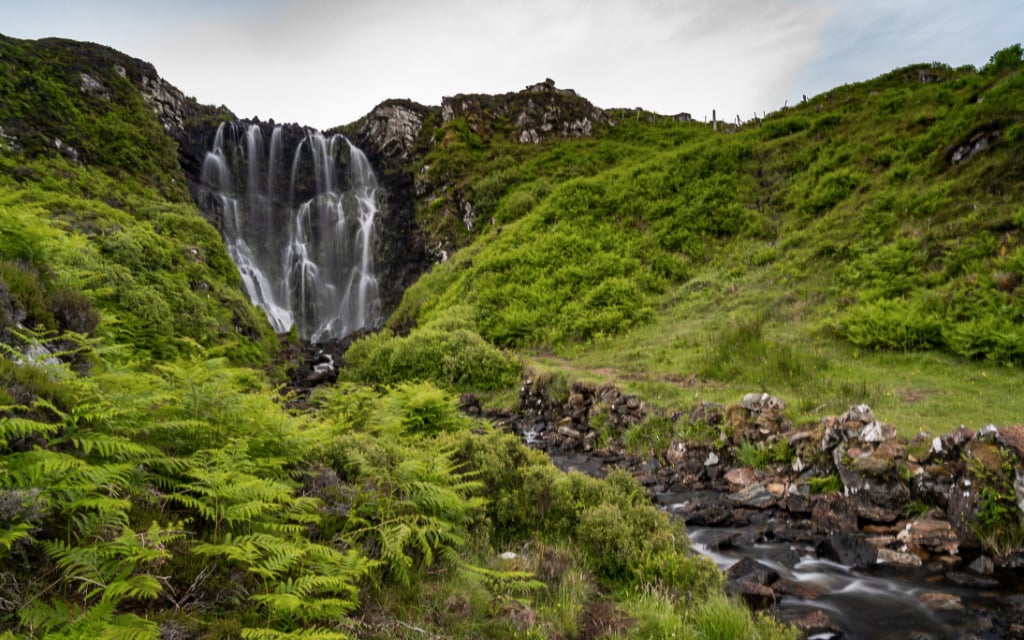
Tip: Book your car well in advance to ensure the best price and choice. Car rental agencies can be found at every airport, as well as throughout Scotland. When booking, make sure that full insurance is included to avoid any unpleasant surprises on site.
21. Orkney – things to do in Scotland
The Orkneys are an archipelago of approximately 70 islands off the northern coast of mainland Scotland. The islands are renowned for their stunning landscapes, rich history and many archaeological treasures, including the Neolithic settlement of Skara Brae, the Ring of Brodgar and Stones of Stenness stone circles and the ancient burial mound of Maeshowe – all part of the UNESCO World Heritage Site Heart of Neolithic Orkney.
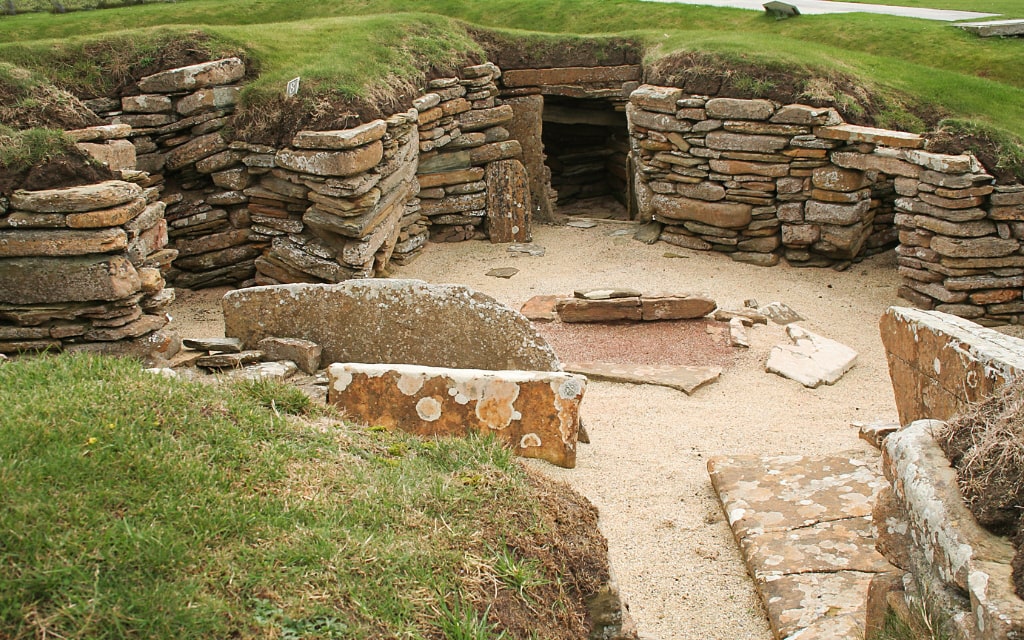
How to get to Orkney
You can get to Orkney by air or sea. If you’re flying, the main airport is Kirkwall Airport, with regular direct flights from several Scottish airports including Aberdeen, Edinburgh, Glasgow and Inverness. These routes are operated by Loganair.
Alternatively, you can take a ferry to Orkney. There are several ferry services, most commonly from Scrabster to Stromness, from Aberdeen to Kirkwall and from John o’Groats to Burwick. The journey takes 90 minutes.
You can also use the ferry for connections between the islands – here you can find timetables and prices. You can get around the island by local buses or rent a car.
You can also get to Orkney as part of an organised guided tour – the trip includes transport from Edinburgh by minibus, hotels with breakfast, and a tour of the Scottish Highlands and the Orkney Archipelago.
22. Shetland
The Shetland Islands are renowned for their rugged beauty, unique wildlife and rich Nordic heritage. Explore ancient archaeological sites such as the well-preserved Mousa Broch, the prehistoric and Norse settlement of Jarlshof and the Shetland Museum and Archive in Lerwick and enjoy the sight of unspoilt nature with its many species of birds, seals and even killer whales.
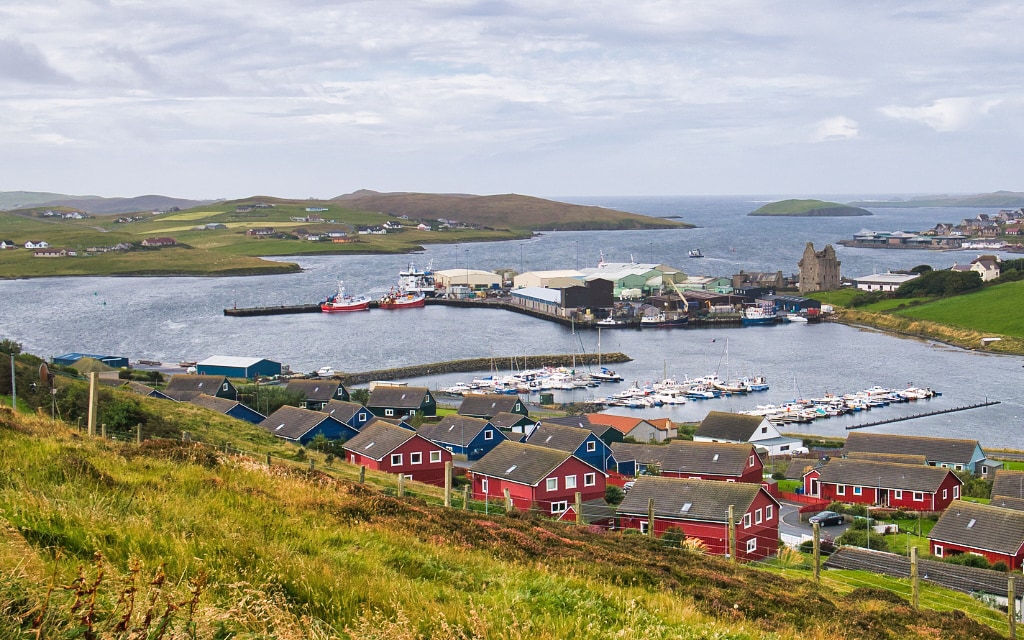
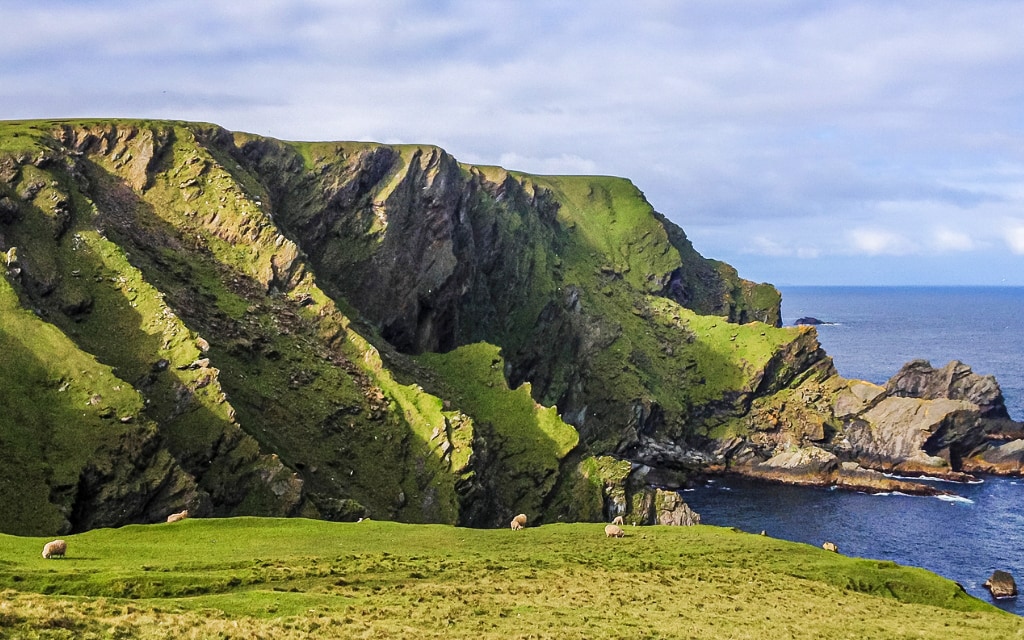
How to get to the Shetland Islands
The Shetland Islands can be reached by air or sea. The main airport serving Shetland is Sumburgh Airport, located at the southern tip of the mainland. Direct flights to Shetland are available from several Scottish airports, including Aberdeen, Glasgow and Inverness, operated by Loganair.
By sea, NorthLink Ferries operates an overnight ferry service from Aberdeen to Lerwick, the capital of Shetland. The journey takes approximately 12 to 14 hours depending on whether the ferry stops in Orkney. This ferry line offers a range of accommodation, from reclining seats to en-suite cabins, and there are plenty of refreshment options.
Once in Shetland, you can explore the islands via an extensive network of inter-island ferries and local buses. For those who prefer to explore at their own pace, car rental services are also available.
23. Hebrides
The Hebrides, often divided into the Inner and Outer Hebrides, are a large and diverse archipelago off the west coast of mainland Scotland. The archipelago is renowned for its breathtaking natural beauty, distinctive Gaelic culture and rich archaeological heritage.
The Hebrides are home to a number of fascinating historical and natural sites, including the world-famous standing stones of Calanais on the Isle of Lewis, the white sandy beaches of Harris and the diverse wildlife of Mull.
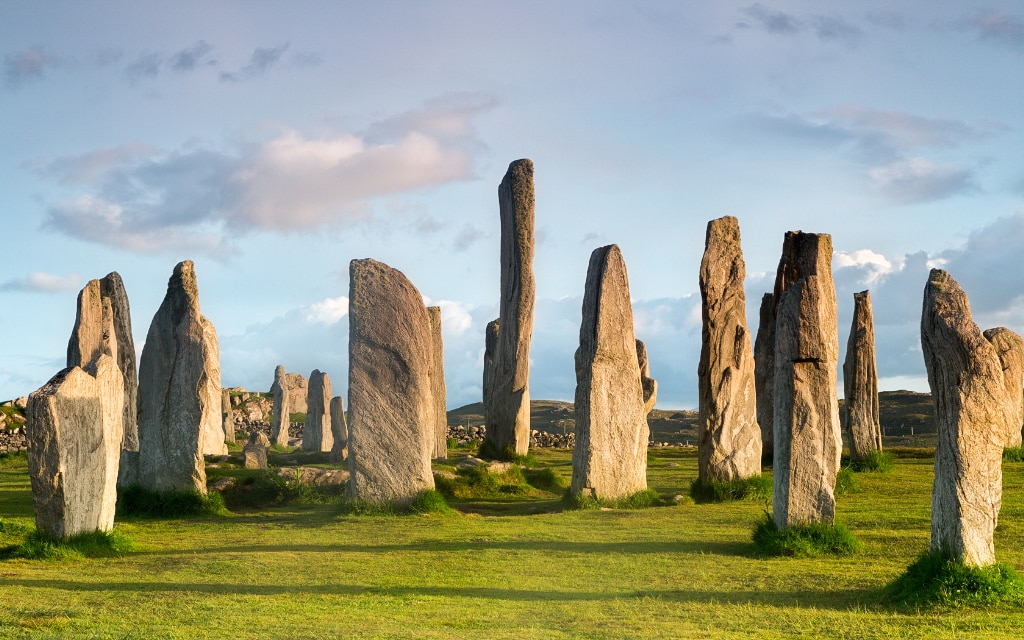
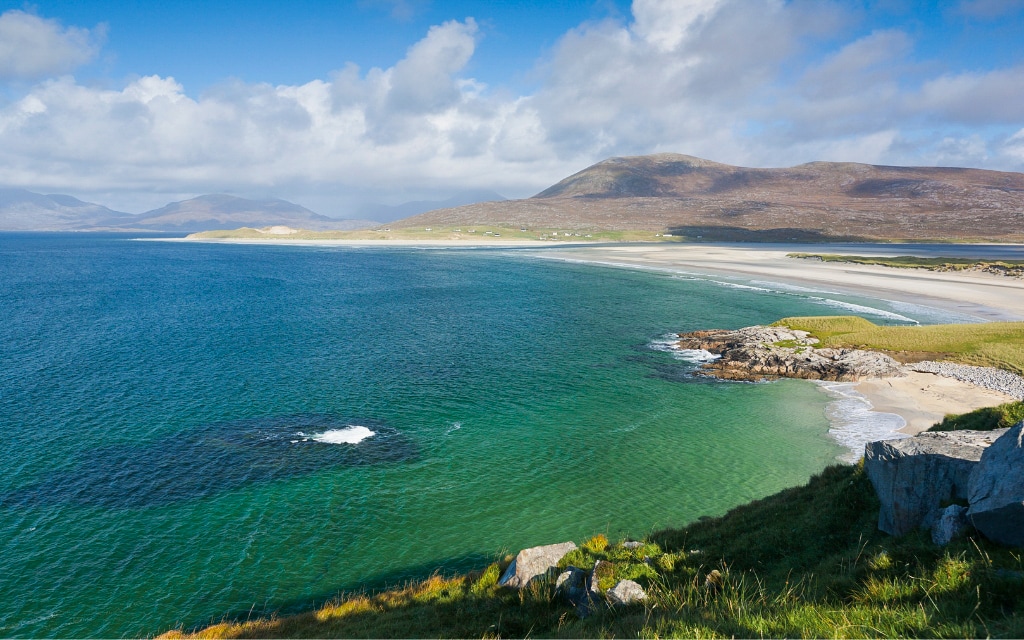
How to get to the Hebrides
The Hebrides can be reached by air or by sea. Loganair flights are available from Glasgow and Inverness to Stornoway on the Isle of Lewis.
By sea, Caledonian MacBrayne (often known as CalMac) operates numerous ferry services to the islands from the mainland. The main routes include Oban to Mull, Uig on Skye to North Uist and Ullapool to Stornoway on the Isle of Lewis. The ferry routes and schedules are quite extensive and offer regular services that are designed for both passengers and vehicles.
Once you’re in the Hebrides, you can explore the islands via local bus routes, car hire or by bike.
Read: The most beautiful places in England
24. Fingal’s Cave and Staffa Island
Fingal’s Cave, located on the uninhabited island of Staffa in the Inner Hebrides of Scotland, is a natural wonder renowned for its acoustics, distinctive hexagonal basalt columns and deep blue water.
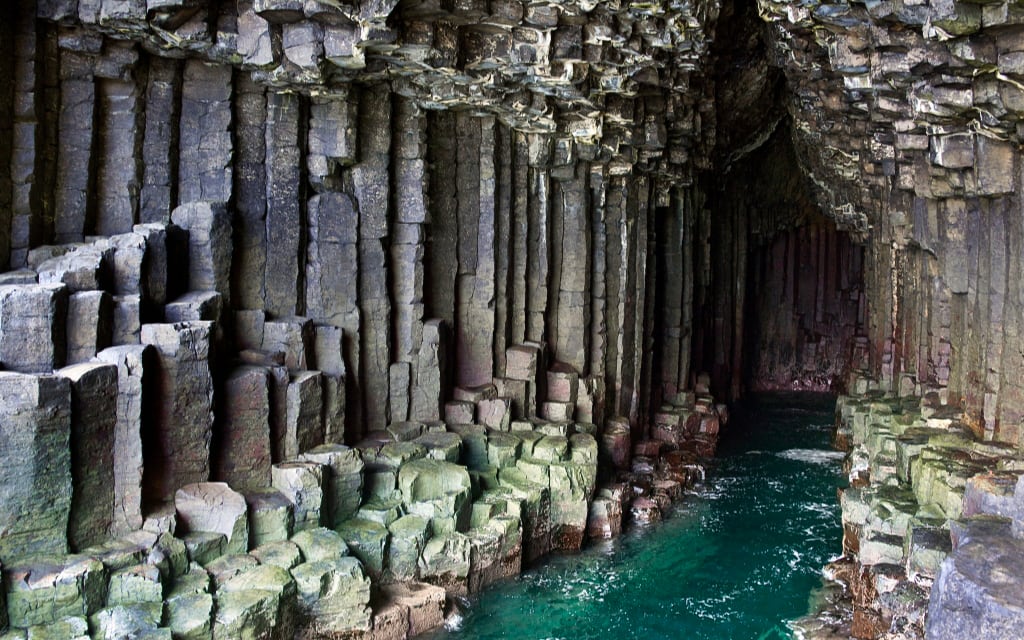
The cave, named after the hero of James Macpherson’s 18th century epic poem, is the inspiration for several famous pieces of music, including Mendelssohn’s “Hebrides Overture” and Pink Floyd’s “Echoes”.
How to get to Fingal’s Cave and Staffa Island
Staffa Island and Fingal’s Cave are accessible by boat trips, which, due to the weather, take place mainly from April to September. Trips usually depart from the main harbour on the Isle of Mull at Tobermory or from the villages of Fionnphort and Iona, also on the Isle of Mull. Boat services also operate from Oban on the Scottish mainland.
25. Isle of Skye – things to do in Scotland
As they say – the best for last. And on the Isle of Skye, this is doubly true.
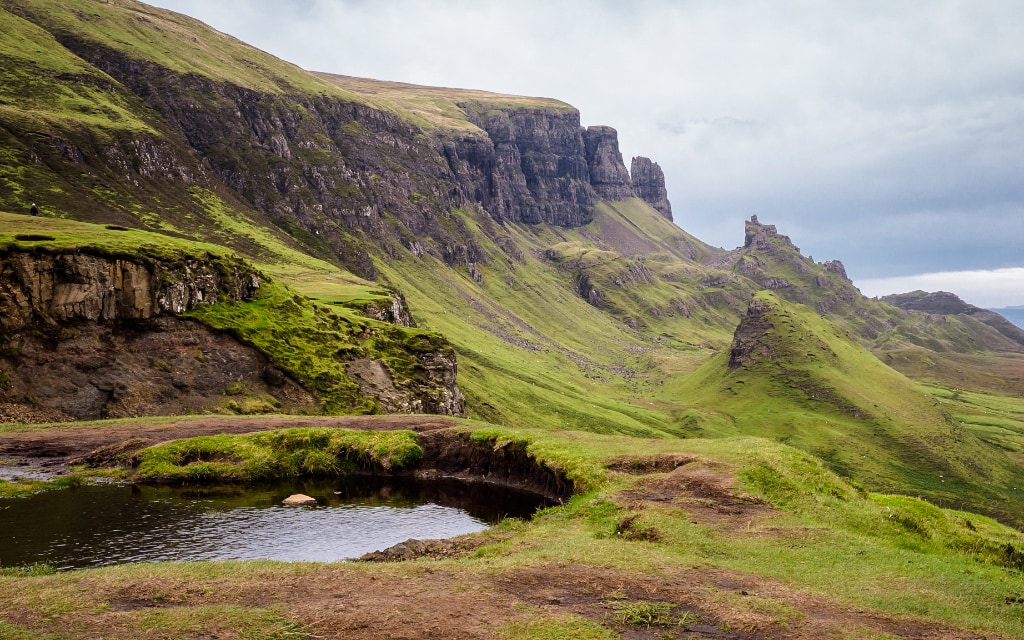
The Isle of Skye, located off the west coast of Scotland, is the largest and arguably the most famous of the Inner Hebrides islands. Renowned for its rugged and dramatic landscape, Skye is a nature lover’s paradise, offering a stunning combination of highlands, peninsulas, sharp peaks and sparkling lochs.
Skye is particularly famous for its geological features such as the extraordinary rock formations of Quiraing, the Old Man of Storr and the basalt columns of Kilt Rock. The island’s rugged coastline is interspersed with picturesque villages, the most notable of which is Portree, the capital of the Isle of Skye.
Visit Dunvegan Castle, the oldest continuously inhabited castle in Scotland and the ancestral home of the MacLeod chieftains. Take a stroll around the Fairy Pools, the bright blue pools of the River Brittle, or the Fairy Glen near Uig.
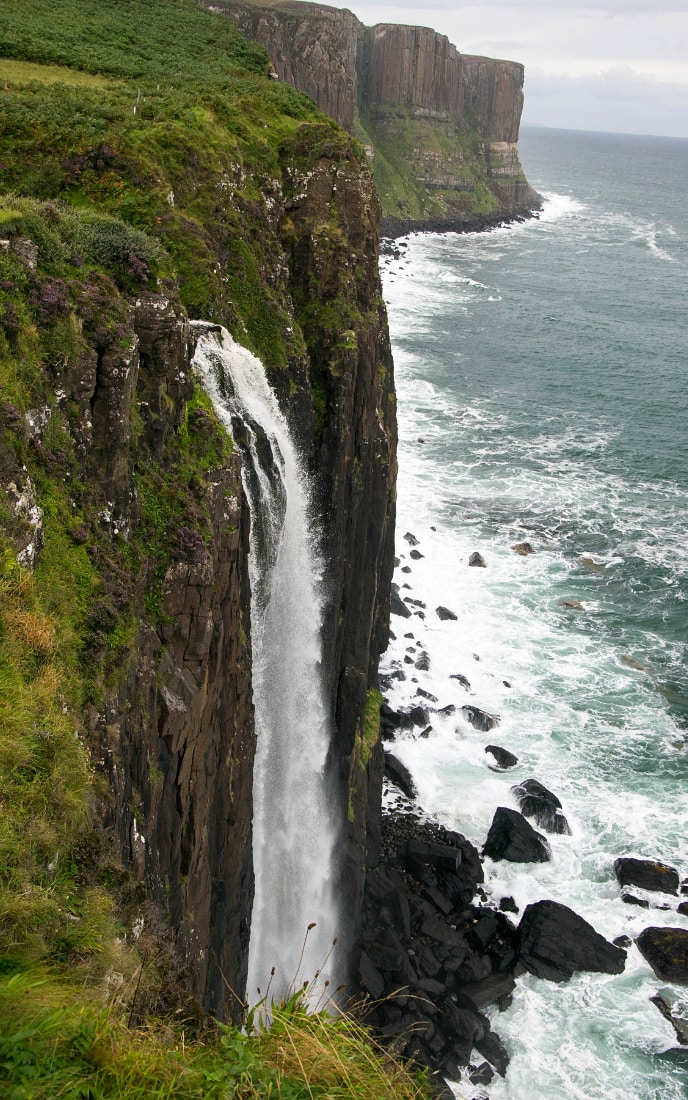
How to get to the Isle of Skye
The Isle of Skye is easily accessible from mainland Scotland via the Skye Bridge. Skye is also linked to the Outer Hebrides and other parts of the mainland by several ferry services operated by Caledonian MacBrayne.
A car is the best way to see the whole of the Isle of Skye. Book your car well in advance to ensure the best price and choice. Car rental companies are located at every airport as well as all over Scotland. When booking, make sure that full insurance is included to avoid any unpleasant surprises on site.
If you’re driving from Edinburgh or Glasgow, expect a 5-hour drive. For this reason, I recommend taking the circular route and visiting places along the way. You can head to Inverness to Loch Ness, the Isle of Skye and then return via the Glencoe Valley or Loch Lomond.
Read: The most beautiful places on the Isle of Skye in Scotland
Where to stay in Scotland
Fort William
Fort William is known as the outdoor capital of the United Kingdom. A strategic base for exploring the Glencoe Valley, West Highland Way and Ben Nevis.
Fort William is a 3-hour drive from Edinburgh or Glasgow, or you can take direct trains and buses from Glasgow. If your base is Inverness, Fort William can be reached in 2 hours.
- Cruachan Hotel Description : Modern and cosy hotel with spectacular views, breakfast included and a restaurant with local cuisine
- The Caledonian Hotel: pleasant 3-star hotel with free breakfast, restaurant and free parking
- Glen Nevis Youth Hostel: Simple, clean accommodation in shared or private rooms suitable for families and groups
Hotels around Glencoe and Ben Nevis 😴
Inverness and Loch Ness
Inverness and the surrounding area is a great place to stay if you want to explore the Scottish Highlands, including Loch Ness and the Culloden Battlefield. Inverness can be reached from Edinburgh or Glasgow in 3 hours by car or direct train.
- Loch Ness Guest House: Comfortable hotel in Fort Augustus steps from Loch Ness at a great price
- Loch Ness Lochside Hostel: Accommodation in single or shared rooms on the shores of Loch Ness
- Whitehouse B&B: Beautiful, cosy accommodation in Fort Augustus on Loch Ness with excellent breakfast and free parking
Best Loch Ness and Inverness Hotels 😴
Edinburgh
Edinburgh, the capital of Scotland, is located in the east of Scotland. Edinburgh Airport is where most of the visitors arrive. You can choose one of the organised tours from Edinburgh or hire a car at the airport and head to the Scottish Highlands, the East Coast or the Cairngorms National Park. The Kelpies statues and Stirling Castle are also a short walk away.
- Cityroomz Edinburgh: Hotel on Princes St, directly opposite the airport bus stop. Rooms and apartments with kitchenettes are available.
- The Haymarket Hotel: This hotel is in a Victorian house on a quiet street on the edge of the centre. It is well connected to the airport. Rooms are stylish, cosy and decorated in a traditional style.
- ibis budget Hotel: ibis hotels are a popular chain of hotels offering smaller but modern rooms with all the necessary amenities. This hotel is ideally located for those looking for accommodation near the airport.
Isle of Skye
Staying on the Isle of Skye allows easy access to natural wonders such as the Old Man of Storr, Fairy Pools and Neist Point.
- Broadford Youth Hostel: Simple, practical accommodation in single rooms (including family rooms) or shared rooms at a good price
- Sligachan Hotel : Fantastic, stylish hotel in the middle of the countryside with spectacular views, free parking and a restaurant and bar
Hotels in Scotland 😴
Glasgow
Scotland’s largest city, Glasgow is known for its vibrant arts scene, rich industrial history and beautiful architecture. As well as Edinburgh, Glasgow has regular flights from many European cities. Loch Lomond National Park and The Trossachs are just 45 minutes away, and it’s also a short drive to The Kelpies and Stirling Castle, or 2 hours to the Glen Coe Valley.
- Euro Hostel Glasgow: Accommodation in single (and family) or shared rooms in the centre near the station
- Clayton Hotel Glasgow City: A cosy four star hotel with spectacular views minutes from the station
- ibis budget Glasgow: Cheap accommodation within walking distance of the centre and free parking
Things do in Scotland – map
HOW TO USE THIS MAP: Above you will find a detailed map of Scotland with tips on the best things to do in Scotland. Click at the top left of the map to see separate layers with highlighted locations. You can hide and show the different layers or click on the icons on the map to see the names of the places mentioned in the Scotland guide. If you want to save the map, star it. For a larger version, click on the icon in the upper right corner.
These were the best things to do in Scotland. Do you have a question? We’ll be happy to answer it in the comments below. Have a safe journey!
Learn more about the UK
SCOTLAND: Check out 25 things to do in Edinburgh (+ more useful information and tips for your trip). Here’s a list of the things to do on the Isle of Skye.
Planning a trip to Scotland? We’ve put together a complete guide how to plan perfect trip to Scotland. A sample itinerary for a roadtrip in Scotland will help you plan your trip.
ENGLAND: The list of the most beautiful places in England includes tips on things to do in England.
LONDON: Read more about things to do in London. To help you plan your trip, we’ve created a 3-day London itinerary. In this article, we share tips on things to do in London with kids.
Summary: Things to do in Scotland
Scotland is home to many iconic landmarks such as historic Edinburgh Castle, the mysterious Loch Ness, the green Isle of Skye, picturesque Glencoe, stunning Ben Nevis and the innovative Falkirk Wheel. In this article you will find detailed information about these places, including a map, additional tips and practical information for a perfect holiday in Scotland.
The best time to visit Scotland is generally during the summer months (June to August), when the weather is warmer and there are a plethora of festivals and events. However, for those who want to avoid the crowds, spring (April to June) and autumn (September to November) also offer pleasant weather and beautiful scenery.
Traditional Scottish foods include haggis, neeps and tatties, black pudding, Scotch pie, Cullen skink and the sweet treat shortbread. Don’t forget to try the world-famous Scotch whisky!
Scotland has an extensive public transport network, including trains, buses and ferries. For a more flexible schedule, consider renting a car, especially if you plan to explore the Highlands or other remote areas.
